
|
|
Well-Kept Czech Secrets - the Tono Engines
Both the MVVS and Vltavan engines were primarily intended as competition powerplants. However, then as now, sport fliers who simply enjoyed flying model aircraft (and actually building them way back then) outnumbered their serious competition compatriots by a substantial margin. This left the door wide open for other Czech manufacturers to enter the market with model engine ranges which were primarily intended for sport-flying use. An amazing number of different Czech manufacturers did so, one of them being the originators of the Tono range which forms the central subject of this article. The Tono engines were manufactured in Vysoké Mýto, a small town in the Pardubice region of the former Czechoslovakia (now Czechia). The highlight of the present article will be a full test report on two representative examples of the Tono engines from their later period in the mid 1960's. Acknowledgements Before getting into the testing of representative examples of the Tono engines, it seems worthwhile for context to present a capsule history of the Tono marque from start to finish. I will preface that section of this article by freely admitting that I personally possess almost no first-hand knowledge of the history of the Tono marque. For this section of the article, I have therefore principally relied upon two primary reference sources, the use of which I hereby freely acknowledge.
The other invaluable source to which reference has been made is the excellent 2004 publication by Jiří Linka and Jan Kafka entitled “České Modelářské Motory” (Czech Model Engines). Unlike Kalina’s book, this work is entirely concerned with engines produced in Czechoslovakia and (later) the Czech Republic. Moreover, it is primarily an illustrative work, containing little text but many excellent photographs with dates and basic technical data. I have reproduced a number of otherwise-unobtainable photographs from this book, a fact which is hereby openly and gratefully acknowledged. Some useful scraps of additional information also came from several Eastern European web sites. Naturally, I’ve almost certainly got some of it wrong, and I live in hopes that some knowledgeable Czech reader may descend upon me and set me straight!! It's happened before ......... If authoritative corrected information becomes available, I will of course amend this article with full acknowledgement. History of the Tono Range
The Tono engines evolved from very low-key beginnings. According to Kalina’s account, the original Tono prototypes were built in 1957 by a pair of then-amateur constructors from Vysoké Mýto. The two enthusiasts were named František Starý and Velké Ćermné. Both 2.5 cc and 5 cc glow-plug engines were made at that time. No structural details were given by Kalina, but the 2.5 cc model was evidently a “special” intended for International speed competition – the sample performance figure given by Kalina certainly suggests this. This model was reported to have turned a 6½” x 9½” prop at 15,000 rpm static – a very good figure indeed by 1957 standards for what was clearly a control-line speed prop. The 5 cc version, however, appears to have been aimed more at the control-line stunt category – it reportedly turned a 9½” x 5½” prop at 11,000 rpm – again, a pretty good performance for a 1950’s-vintage 5 cc engine turning a fairly typical stunt prop on straight fuel.
The attached illustration from Linka and Kafka’s book shows that this version of the Tono 2.5 cc model featured crankshaft front rotary valve (FRV) induction. Despite the plain bearing crankshaft, the engine's racing heritage was reflected in its swept-back exhaust stack which was evidently modelled upon the 1955-1957 MVVS designs. A similarly-configured diesel version of this engine was also produced at around the same time under the Tono 2.5 D designation. As far as I'm presently aware, this was the only diesel ever to appear under the Tono brand. The success of these engines encouraged Starý to take the steps necessary to enable him to engage in the larger-scale series production of model engines for the Czech national market. In 1959 he introduced the first truly commercial Tono glow-plug model, a very neat and seemingly sturdy 1.16 cc unit designated the Tono 1. This designation established something of a Tono tradition by under-representing the engine’s true displacement!
Like its 2.5 cc predecessors, the engine utilized FRV induction, but it proved to be the last Tono design to do so. It weighed 74 gm (2.61 ounces), a not unreasonable weight for an engine of its displacement and sturdy construction, especially if it did incorporate a single ball-race. It was this model which introduced the streamlined bullet-shaped front end that was to become a Tono “trademark” style. According to Kalina, this engine was produced in relatively small quantities. I’ve certainly never encountered one myself. Nonetheless, this very servicable little motor was evidently well received by those who experienced it, getting its fledgling manufacturer off to a good start. In 1960 the range was expanded through the introduction of a series of larger glow-plug engines having displacements of 4.4 cc, 5.6 cc and 6.6 cc, all displaying a generally similar design layout. It’s a little odd that Starý chose to produce a series of engines covering such a relatively narrow range of displacements for the most part, but no doubt he had his reasons.
The most obvious change which these three motors exhibited from the basic design of the Tono 1 was the adoption of rear drum valve induction in place of the FRV induction of the earlier model. This was to remain a feature of all the Tono engines from this point forward. The drum valves were very well-designed, with large-diameter drums having extremely generously-dimensioned ports. Full advantage was taken of the fact that the drums were not mechanically loaded in any way, hence being able to tolerate being opened up to a far greater extent than would be possible with a crankshaft front rotary valve of comparable diameter. The plain bearings for the drums were blind-bored within the rear casting, thus eliminating the annoying bleed of oil from the end of the bearing which necessitated the use of a rubber seal on other similar designs such as the Super Tigre rear drum valve models. On many (but not all) examples of the 5.6 cc and 6.6 cc models, the entire drum valve assembly, including the intake venturi and needle valve assembly, was secured to the main crankcase by two countersunk screws. A word of warning – do not overtighten these screws! Countersunk screws exert considerable wedging forces upon the surrounding material, and overtightening could actually fracture the relatively skimpy “mouse ear” eyelets which accommodate these screws. Like all of the subsequent Tono models, the new designs for 1960 used twin ball-race crankshafts and featured the trade-mark “bullet” front end. The streamlined front end offered outstanding rigidity to the main bearing structure, at some cost in terms of weight. At this point in time, deflector pistons were still employed, this being the established approach to the design of cross-flow loop-scavenged engines at that time (which Super Tigre were even then in the process of challenging).
The Tono engines remained for the most part behind the Iron Curtain, hence attracting very little notice in the Western modelling media. However, a few of them found their way to the West by devious means. The original Tono 5.6 cc and 6.6 cc engines were mentioned in the “Motor Mart” feature of the September 1961 issue of “Aeromodeller” magazine, along with an illustration. The photo caption stated that the 5.6 cc version would swing a 10¼ by 7¼ prop at 14,000 rpm, which was really good going by 1961 standards for an engine of that size running on straight fuel! Neither the "Aeromodeller" article nor Kalina's book provide any claimed performance figures for the larger 6.6 cc model. None of the Tono engines appears ever to have been tested by any Western modelling magazine. Accordingly, there's no independent confirmation of any of the published performance claims. That is an omission which will be rectified as far as possible in a later section of the present article. In 1963 the 6.6 cc model was evidently dropped from the range, while the design of its 5.6 cc companion was revised. The most significant change introduced at this time was the design of the piston and cylinder. A flat-topped deflectorless piston was now used in conjunction with a single extremely large transfer port which was steeply bevelled on its upper edge to direct the incoming charge upwards towards the top of the cylinder. This transfer port was fed by a bypass passage of considerable dimensions.
The Tono designers were obviously among the first commercial manufacturers to follow the Super Tigre lead. The transfer in the Tono engines overlaps the exhaust almost completely, although there is a very short exhaust blow-down period. My own illustrated examples of the Tono engines both have two shallow grooves cut in the piston wall near the top and bottom respectively, presumably to assist in retaining oil for lubrication and sealing of the cylinder and piston. Overall, the Tono engines are extremely well-designed in terms of their breathing ability. In many respects, they appear more as competition engines than as the sports powerplants which they were evidently intended to be. They were also manufactured throughout to very high standards. I am not at all surprised by the relatively high peaking speeds claimed for them, nor for the most part by the claimed power outputs. The 5.6 cc model of 1963 also featured a minor revision to its displacement, becoming a 5.43 cc engine with slightly revised bore and stroke measurements of 20 mm x 17.3 mm. It weighed 230 gm in this form, and produced a claimed output of 0.720 BHP at 12,000 RPM. This claim seems more than a little optimistic to me! Given the fairly advanced specification of the engine with its revised porting, twin ball-race shaft and very efficient drum valve, I could accept the claimed BHP figure if the peak rpm figure were rather higher. As it is, the implied torque at 12,000 RPM takes some believing for a 1963 engine of this displacement………. This is really odd, because the other claimed performance figures for these engines appear by no means unreasonable to me – this one stands out! Perhaps the stated peak rpm figure is a simple misprint in Kalina’s book that wasn’t caught. It seems possible that the peaking speed was actually 17,000 RPM – it’s quite easy to mistake a Continental 7 for a 2 in passing, particularly if the original figure was hand-written.
The rather odd 1963 flirtation with the 5.43 cc model didn’t last long, and by 1964 the design had been once again revised to return it to its former 5.6 cc displacement, the bore remaining at 20.0 mm but the stroke being increased to 17.7 mm for a calculated displacement of 5.56 cc (0.339 cuin.). The case was also revised to accommodate a centrally-pivoted exhaust baffle plate for use in conjunction with an R/C carburettor. The tapped baffle plate mounting hole could also be conveniently used to mount a muffler. The engine was offered in an un-throttled “Sport” version for free flight and control line as well as in a designated “Sport R/C” version with throttle. The flat-topped deflectorless piston technology introduced in the previous year was naturally retained. The “Sport” version of this 1964 model was reportedly very highly regarded in Czechoslovakia for control-line stunt use. It is an example of this model which is available for testing, as reported in the following section of this article.
Whatever the truth of this matter, my long-ago preliminary tests on my own illustrated example of the 5.6 showed it to be an extremely powerful runner which definitely liked to be given its head in terms of operating speeds. More on that subject in the following section of this article. The weight given by Kalina for this model is 246 gm (8.68 ounces), although my own example weighs in at 261 gm (9.21 ounces) as illustrated. Regardless, the engine was undoubtedly a little heavier than its 5.43 cc predecessor. Its weight is certainly very much on the high side for an engine of this displacement, but there seems to be little doubt that the specific output is also substantially greater than average also - the claimed figures strongly suggest this.
By this time, the R/C market was becoming increasingly dominant. Accordingly, the Tono 3.5 was primarily intended for use in R/C model aircraft and model cars, having an exhaust stack which was drilled and tapped for an R/C exhaust baffle of the type then much in favour. However, an un-throttled “Sport” model continued to be offered, as illustrated. Kalina reported a claimed output of 0.432 BHP at 15.000 RPM. Based on my own initial experiences with running this example, I would have said that this figure was entirely credible under the right conditions – the engine is an extremely strong runner, with a definite preference for the higher operating speeds. Again, more information regarding this model’s actual performance will be presented in the next section of this article. The Tono design team was very busy at this time, because in the same year of 1964 the factory also released a 10 cc model which followed the same structural pattern as all the rest. The bore and stroke of this, the Like the other models in the range, the Tono 10 was made available in both un-throttled and throttle-equipped versions. The R/C version was simply designated as the Tono 10 while its un-throttled companion retained the “10 Sport” designation of its un-throttled predecessors. Later in 1964, the design of the Tono 10 was amended to include a twin-plug head. This version of the engine was known as the Tono 10 “Super”. In all other key respects, the design of the engine was unchanged. As usual, both R/C and un-throttled “Sport” versions of this revised model were produced. As far as I can presently determine, this was the last new model introduced by the Tono factory. It appears that no further development took place and that production of the Tono range ended at some point in the latter half of the 1960’s. The increasing political tensions within the country which culminated in the Soviet invasion of August 1968 may have had something to do with this.
I’m not at all clear on how many of these engines were made or when and under what circumstances production ceased. I’ve seen some Eastern European websites which list substantial numbers of these engines for sale from time to time, so they appear to be relatively common in that part of the world. This implies that they were circulated in significant numbers within their zone of origin, although they seem to have retained the gravity die-cast cases throughout, which suggests a steady rather than spectacular production rate.
It's apparent that my 3.5 and Bill Wells' 5.6 are very early examples, while my 5.6 number 2551 is presumably a relatively late product of that variant. On page 68 of his well-known “Collector’s Guide to Model Aero Engines”, the late O. F. W. Fisher describes engine number 2708 which he defines as an example of the ”Tono .35”, presumably the 5.6 cc model. Apart from these serial numbers, the only other identification was the stylized “TONO” logo cast in relief onto the bypass passages. The evidence provided by the serial numbers reported above is far too skimpy to provide any basis for an authoritative estimate of production figures. All that can be said is that we appear to have evidence for the production of at least 830 examples of the 3.5 cc model and 2600 examples of the 5.6 cc variant. I trust that there’s enough information in the above summary to demonstrate the fact that this was a well thought-out and extremely well-executed line of quality model engines having a number of pleasingly out-of-the-rut characteristics to go along with their excellent performance! If they had been made available in the West, I have no doubt that they would have been very well received. Fair enough – setting aside all published performance claims, how do they actually run? Time to seek some answers to that question! The Tono 3.5 cc and 5.6 cc Models on Test
One factor that my notes from those early trial runs do reflect is the previously-mentioned inadequacy of both the prop driver knurling and the slot-head prop retention screws. I recorded the fact that both engines displayed a chronic tendency to loosen their props during starting, a problem which was acerbated by their relatively high compression ratios which encouraged kick-back. So as a preliminary step this time, I made a pair of hexagonal-head prop mounting bolts to use for testing purposes, enabling me to tighten the various props very securely. For reference, the threads are M5x0.8 and M4x0.7 for the 5.6 cc and "3.5" cc models respectively. The engines were clearly designed to be operated on a low or no-nitro fuel. The volumetrically-measured compression ratios of both of these particular examples works out at 8.5:1. I used a brew containing 5% nitro – the lowest of which I had an available supply. This should be quite compatible with an 8.5:1 compression ratio. I also used a cold glow-plug to minimize any chance of pre-ignition. First up was the "3.5 cc" unit no. 0139. Although that is not its true displacement, I will refer to it as such from this point onwards in recognition of the fact that this was after all the name given to it by its manufacturers. I began with an APC 9x6 prop, which I felt would probably be the heaviest load with which this engine should be expected to deal.
Once running, the engine proved to be a very satisfactory performer indeed. It ran very smoothly with an extremely "authoritative" exhaust note (it was loud!) and was easy to set for optimum performance. Needle response was never in the least bit ambiguous - the optimum setting was well delineated, while the wire spring used for needle setting retention functioned perfectly. Running was smooth and miss-free at all speeds tested. There was no sign of sagging at any point during the test. Given the manufacturer's claims mentioned earlier, I was expecting this engine to peak in the vicinity of 15,000 RPM or thereabouts. I therefore decided in advance that I would push the engine up to around 16,000 RPM on test to get a clear picture of its performance. That decision taken, I ran a series of test props beginning with the APC 9x6 fitted initially. The engine performed flawlessly throughout the test. Speeds on the various props were as follows, along with the derived power curve.
The engine delivered what I consider to be an excellent performance for a 1964 sports glow-plug motor of its displacement. It seems to have developed around 0.356 BHP @ 14,000 RPM. While falling somewhat short of the manufacturer's claim cited earlier, this is still a more than acceptable performance for a sports engine of this displacement and vintage using a low-nitro fuel. An 8x6 or 9x5 prop would doubtless work well for control-line, while a 9x4 appears to be appropriate for free flight and R/C applications. One noteworthy characteristic of the derived power curve is its relative flatness. The engine is developing 0.34 BHP (95% of its peak) or better at all speeds between 12,500 and 14,900 RPM. Those figures reflect the engine's excellent operational flexibility.
I began the test of the 5.6 cc model using an APC 10x6. The engine swung this with great authority at a steady 11,000 RPM - a promising start! As before, I worked the engine up to a maximum speed of just under 16,000 RPM. The motor seemed to take this in stride - the faster it ran, the happier it seemed. The figures achieved with the various props tested are shown in the following table, along with the derived power curve.
Once again, an excellent performance for a 1964 sport glow-plug motor of this displacement running on a low-nitro fuel. The engine delivered a peak output of around 0.591 BHP @ 14,700 RPM. Again, this falls somewhat short of the claimed performance cited by the manufacturer. However, it is entirely possible that those figures were As it stands, the 5.6 delivered a somewhat higher specific output than its smaller relative. It shared the same flexibility in terms of its load capacity - it was developing 0.560 BHP (95% of its peak) at all speeds between 13,400 and 15,600 RPM. Propping the engine for any airborne speed within that range would extract its best performance. Indications are that a "fast" 10x6 would be an excellent C/L prop, while for R/C or free-flight work a 10x4 would work well. One point that may be made here is that this test provided no support at all for the previously-cited claim that the 1961 version of the Tono 5.6 would turn a 10¼ by 7¼ prop at 14,000 rpm on straight fuel. Frankly, I never placed much credence upon that claim, which would have placed the Tono streets ahead of any contemporary 5.6 cc (.35 cuin.) glow-plug motor of its day. My test results for the presumably faster 10x6 props seem to settle the issue pretty convincingly. My best guess is that the rpm figure cited in the article was a misprint. Overall, a very satisfactory double test! Both engines came through their ordeal with flying colours and appeared ready to keep going as long as desired. Both glow-plugs also survived a good bit of leaned-out running. With their fine handling and running qualities as well as their high standard of construction, both engines would doubtless serve their owners very well indeed over the long haul. Conclusion
I hope that I've made it clear that any present-day collector or flier who has the opportunity to acquire one of these engines will be getting a product which possesses considerable merit. These motors don't exactly grow on trees these days, but they do show up from time to time on eBay and elsewhere. Anyone interested in acquiring an example should be able to find one with a little patience. And if you do, I very much doubt that you'll be disappointed. Hats off to František Starý for a challenge well met!! _________________________ Article © Adrian C. Duncan, Coquitlam, BC, Canada First published October 2018 |
||
| |
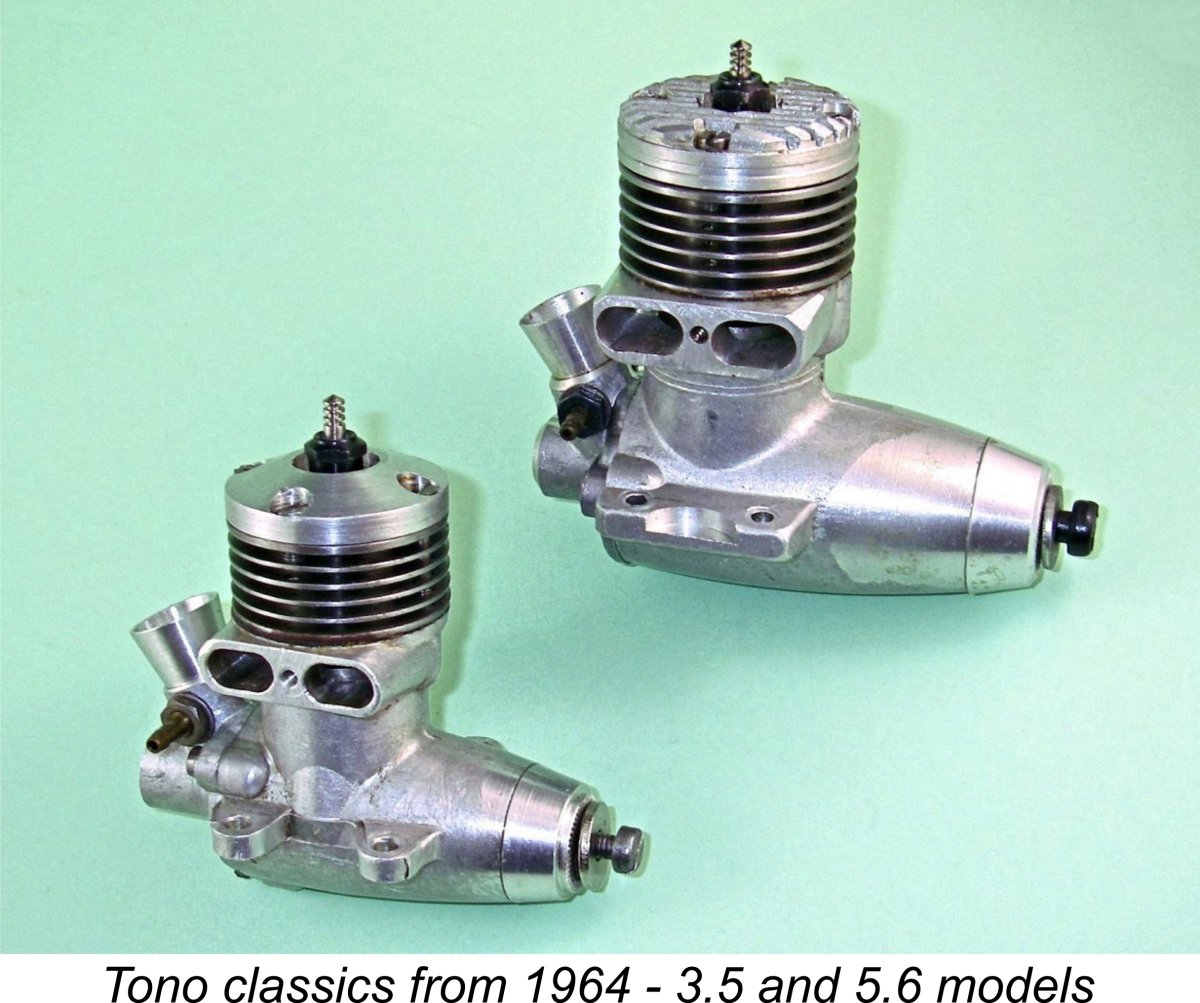 In other articles, I've covered the history of two of the more prominent model engine ranges which had their origins in 1950’s Czechoslovakia (now Czechia). These were the famous and extremely successful
In other articles, I've covered the history of two of the more prominent model engine ranges which had their origins in 1950’s Czechoslovakia (now Czechia). These were the famous and extremely successful 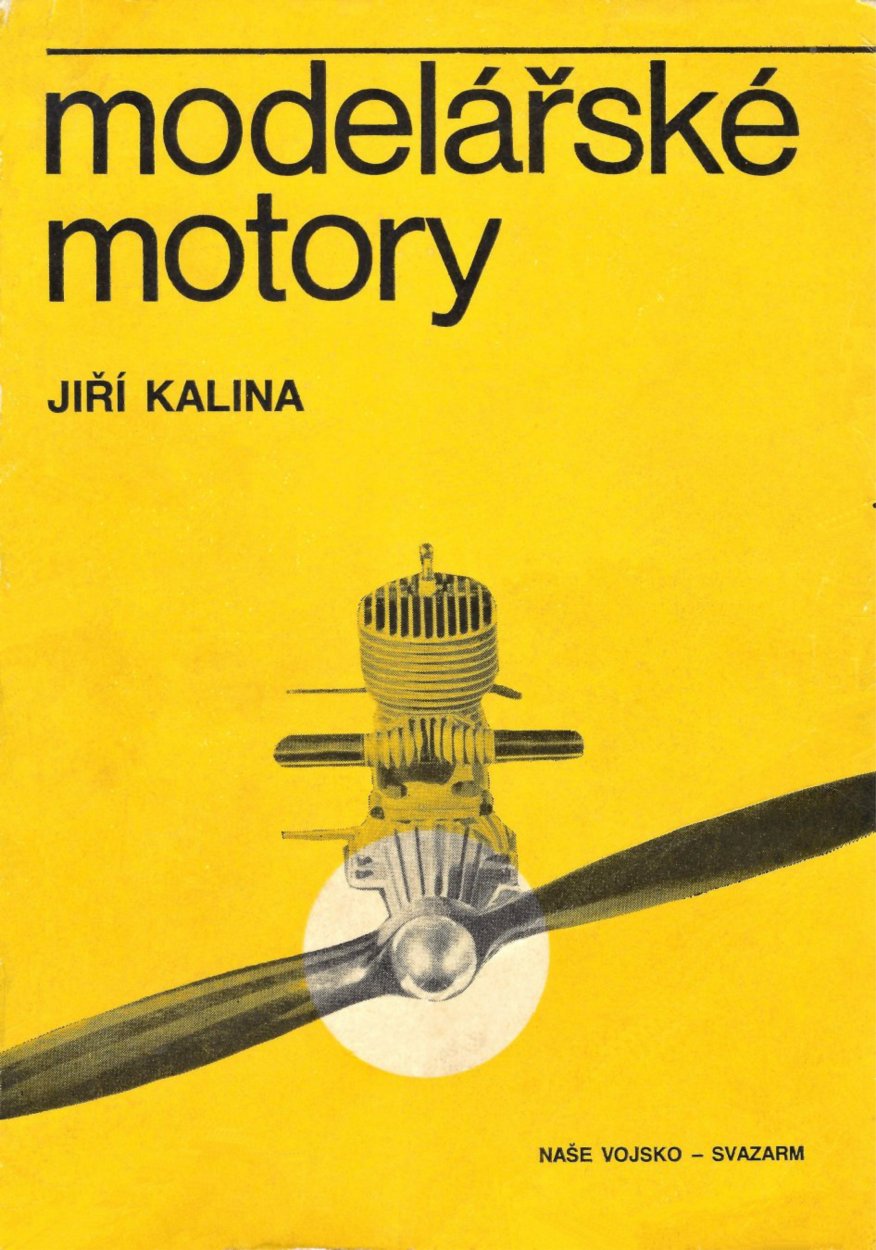
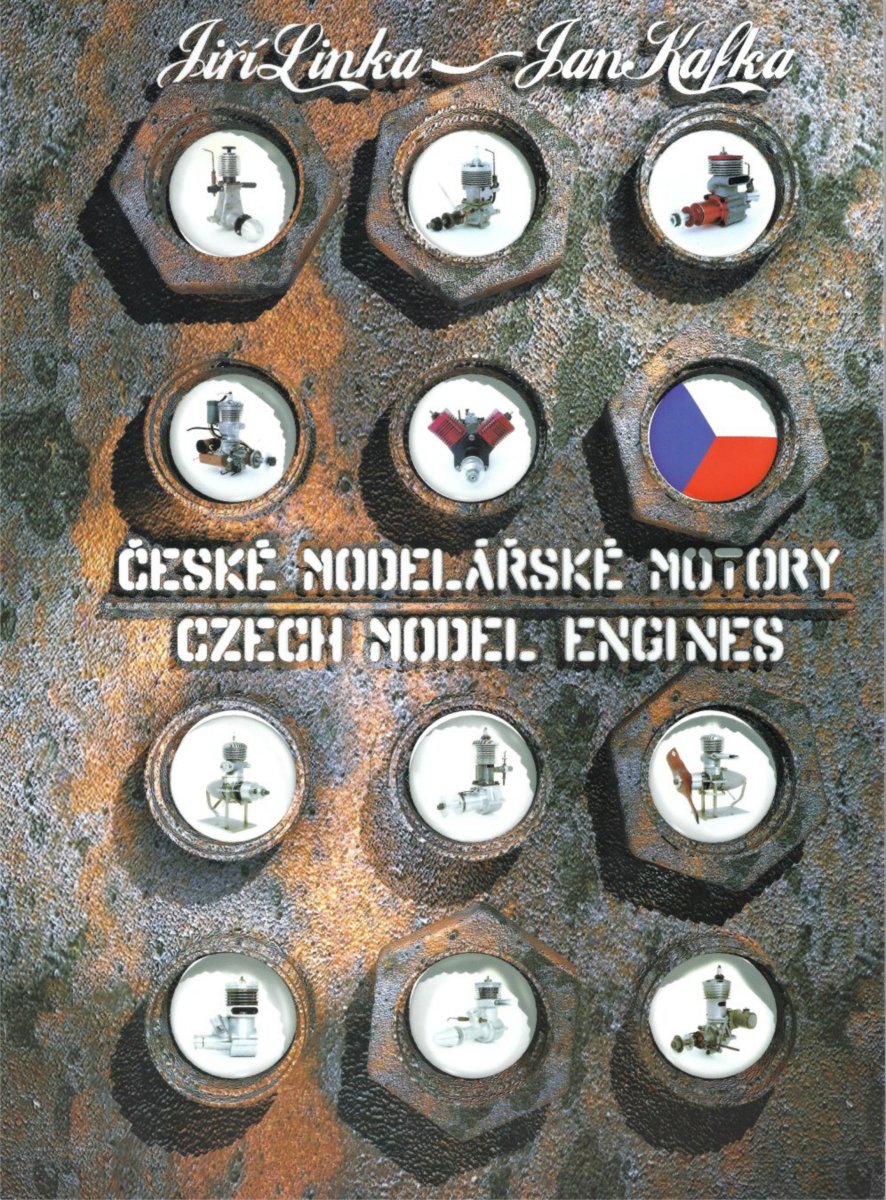 The first of these is Jiri Kalina’s Czech-language book entitled “Modelářské Motory” (Model Engines) which was published in Prague in 1980. Although the book is by no means confined to Czech engines, it does include a fair amount of coverage of model engine ranges from the former Czechoslovakia. The Tono engines are covered in some detail on pages 167 – 170 of Kalina’s book, and a few of them are illustrated therein. Much of what follows is culled from a translation of Kalina’s account with a few bits thrown in from other sources, both written and verbal. I used my handy Czech dictionary and some state-of-the-art scanning and translation software to get the sense of Kalina’s text.
The first of these is Jiri Kalina’s Czech-language book entitled “Modelářské Motory” (Model Engines) which was published in Prague in 1980. Although the book is by no means confined to Czech engines, it does include a fair amount of coverage of model engine ranges from the former Czechoslovakia. The Tono engines are covered in some detail on pages 167 – 170 of Kalina’s book, and a few of them are illustrated therein. Much of what follows is culled from a translation of Kalina’s account with a few bits thrown in from other sources, both written and verbal. I used my handy Czech dictionary and some state-of-the-art scanning and translation software to get the sense of Kalina’s text.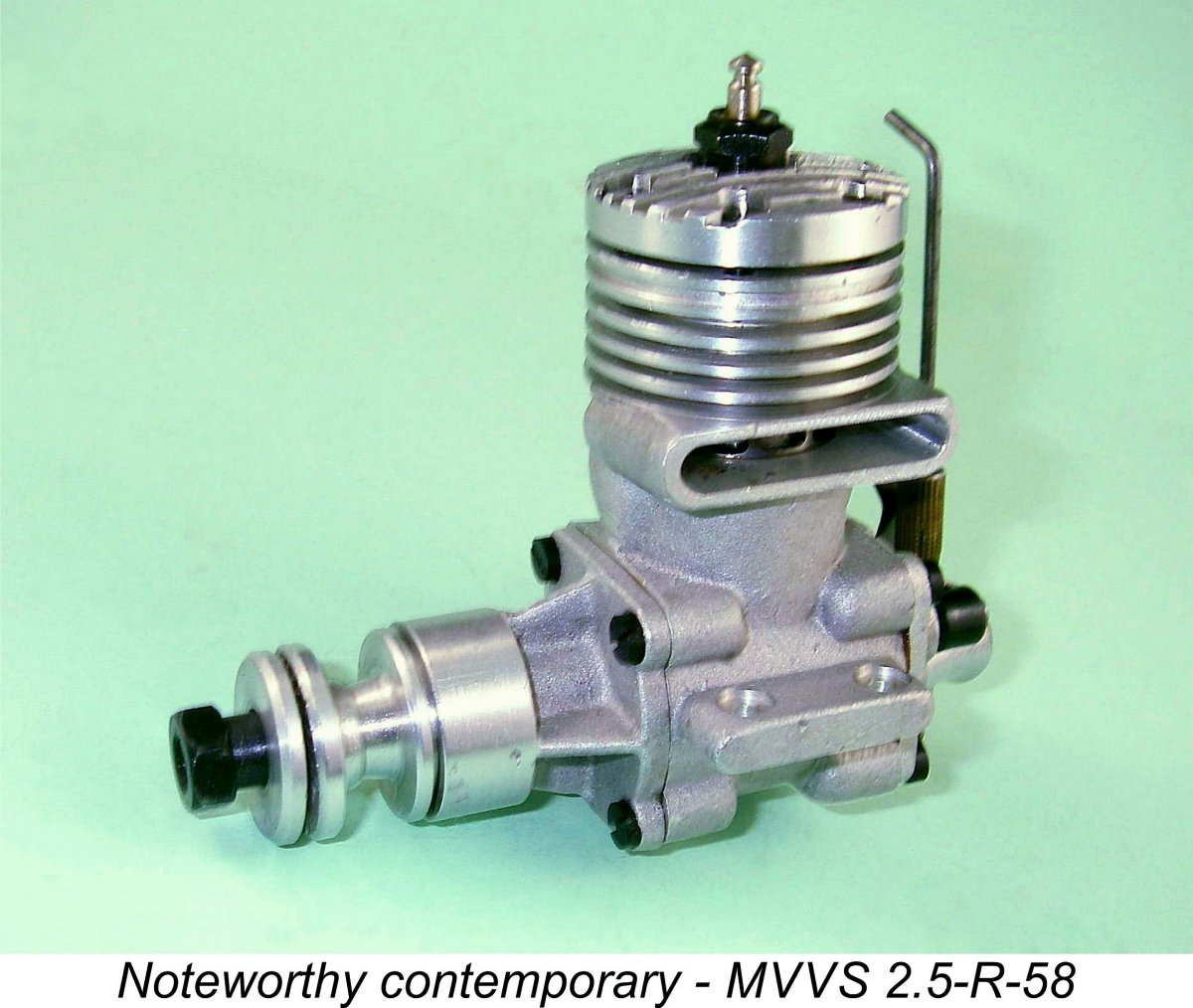 Unlike their MVVS contemporaries, the vast majority of the Tono engines were not custom-built specials created on an individual basis for a few of Czechoslovakia’s leading competition flyers regardless of cost. Rather, they started life as amateur productions intended for their makers' own use. These evolved over time into a series of production models which were predominantly intended for the use of sport flyers in the Iron Curtain zone of Eastern Europe, as it was back then. We're talking 60 years ago and counting here .........
Unlike their MVVS contemporaries, the vast majority of the Tono engines were not custom-built specials created on an individual basis for a few of Czechoslovakia’s leading competition flyers regardless of cost. Rather, they started life as amateur productions intended for their makers' own use. These evolved over time into a series of production models which were predominantly intended for the use of sport flyers in the Iron Curtain zone of Eastern Europe, as it was back then. We're talking 60 years ago and counting here ......... 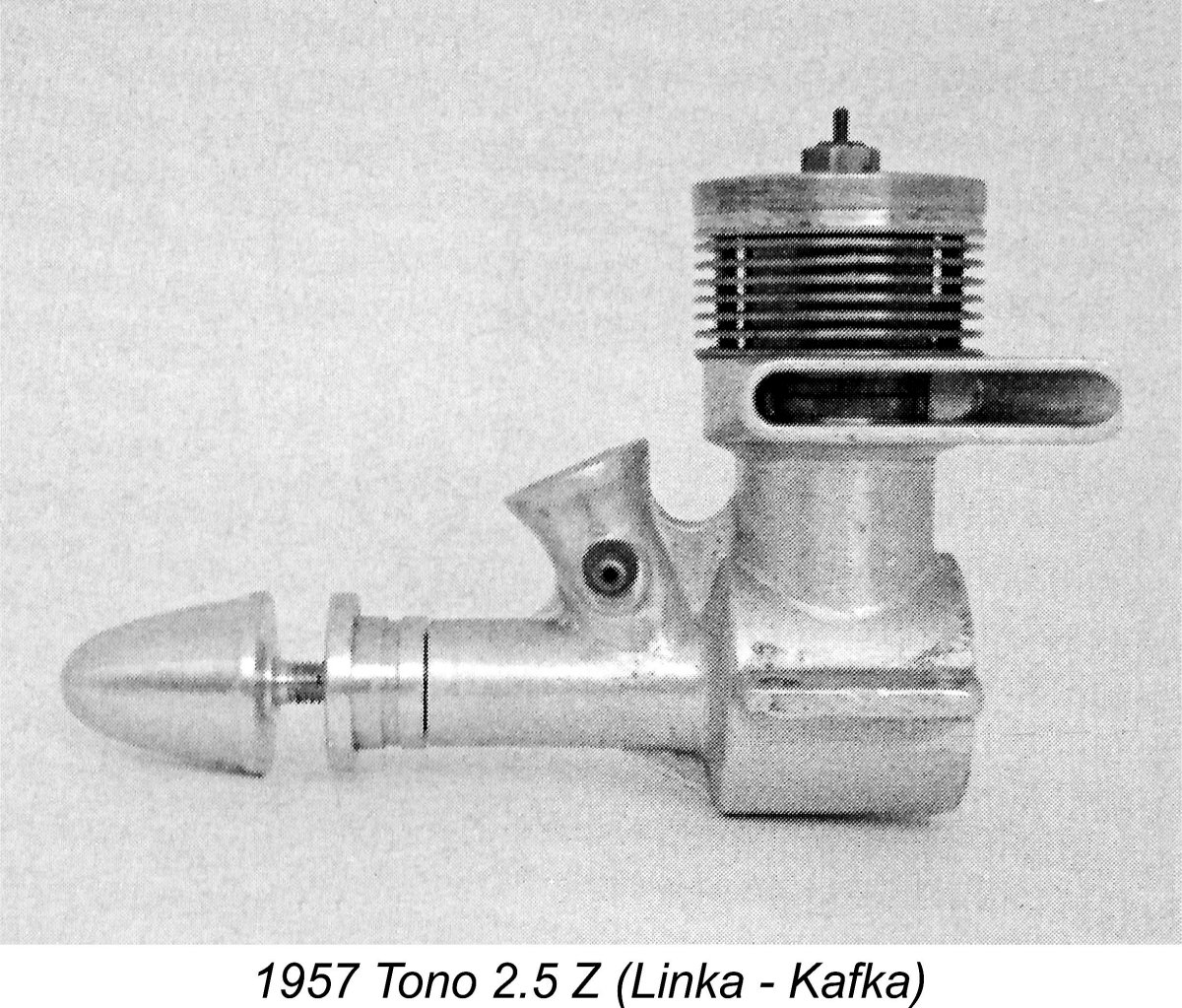 I have been unable to uncover any design details of the all-out racing version of the 2.5 cc model. It was presumably a ball-bearing design which may well have featured rear rotary disc valve induction – I have no way of knowing for sure. However, what is certain is that a few engines presumably based upon this model were produced in plain-bearing form under the designation Tono 2.5 Z. These were evidently marketed locally for the most part.
I have been unable to uncover any design details of the all-out racing version of the 2.5 cc model. It was presumably a ball-bearing design which may well have featured rear rotary disc valve induction – I have no way of knowing for sure. However, what is certain is that a few engines presumably based upon this model were produced in plain-bearing form under the designation Tono 2.5 Z. These were evidently marketed locally for the most part. 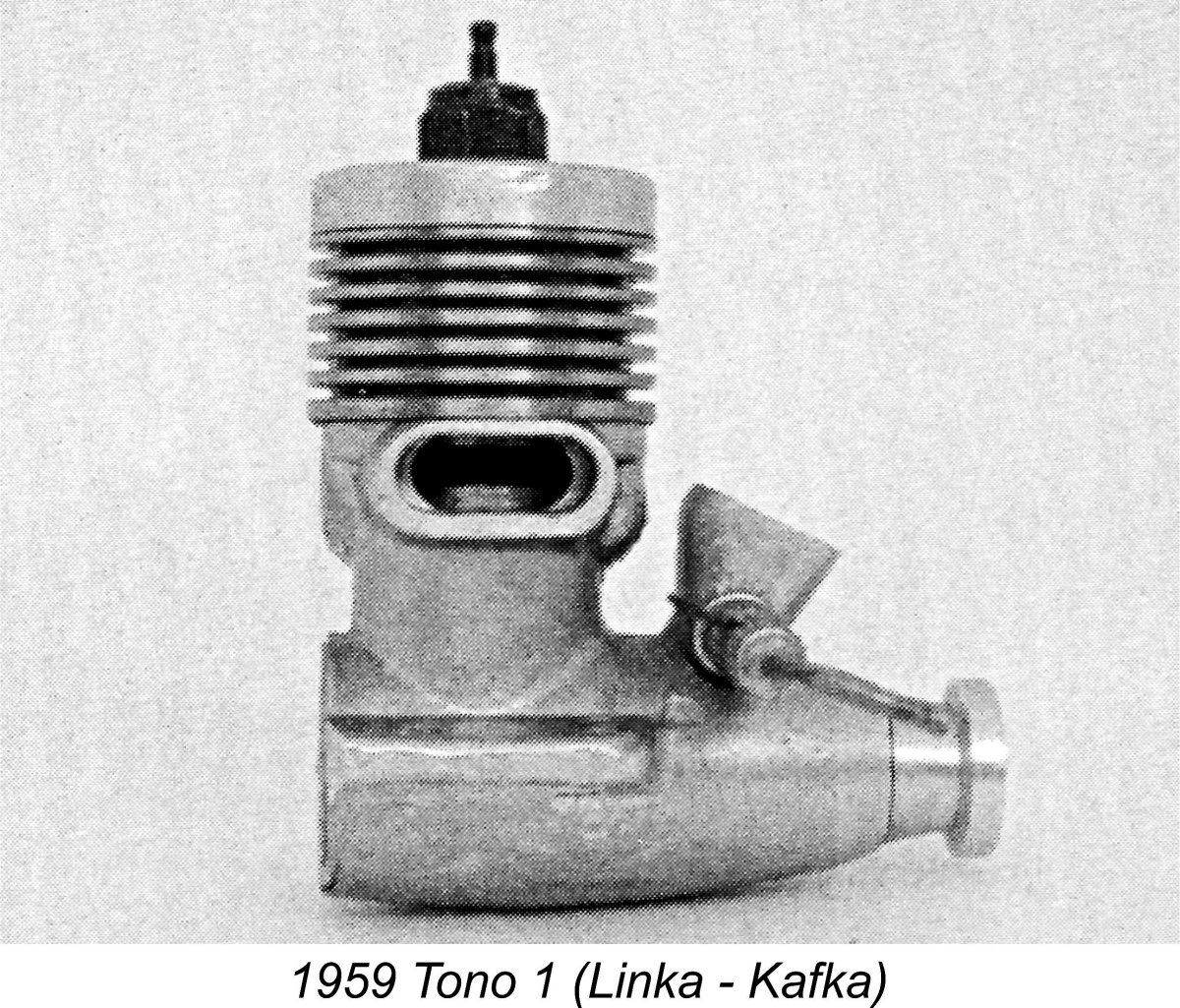 Like all of the Tono models both before and after, this rather chunky but nonetheless attractive little motor featured a one-piece steel cylinder with integrally-formed cooling fins. It had bore and stroke dimensions of 11 mm x 11 mm respectively for a true calculated displacement of 1.16 cc. It may well have been equipped with a single rear ball race - at present I have no information regarding that point.
Like all of the Tono models both before and after, this rather chunky but nonetheless attractive little motor featured a one-piece steel cylinder with integrally-formed cooling fins. It had bore and stroke dimensions of 11 mm x 11 mm respectively for a true calculated displacement of 1.16 cc. It may well have been equipped with a single rear ball race - at present I have no information regarding that point. 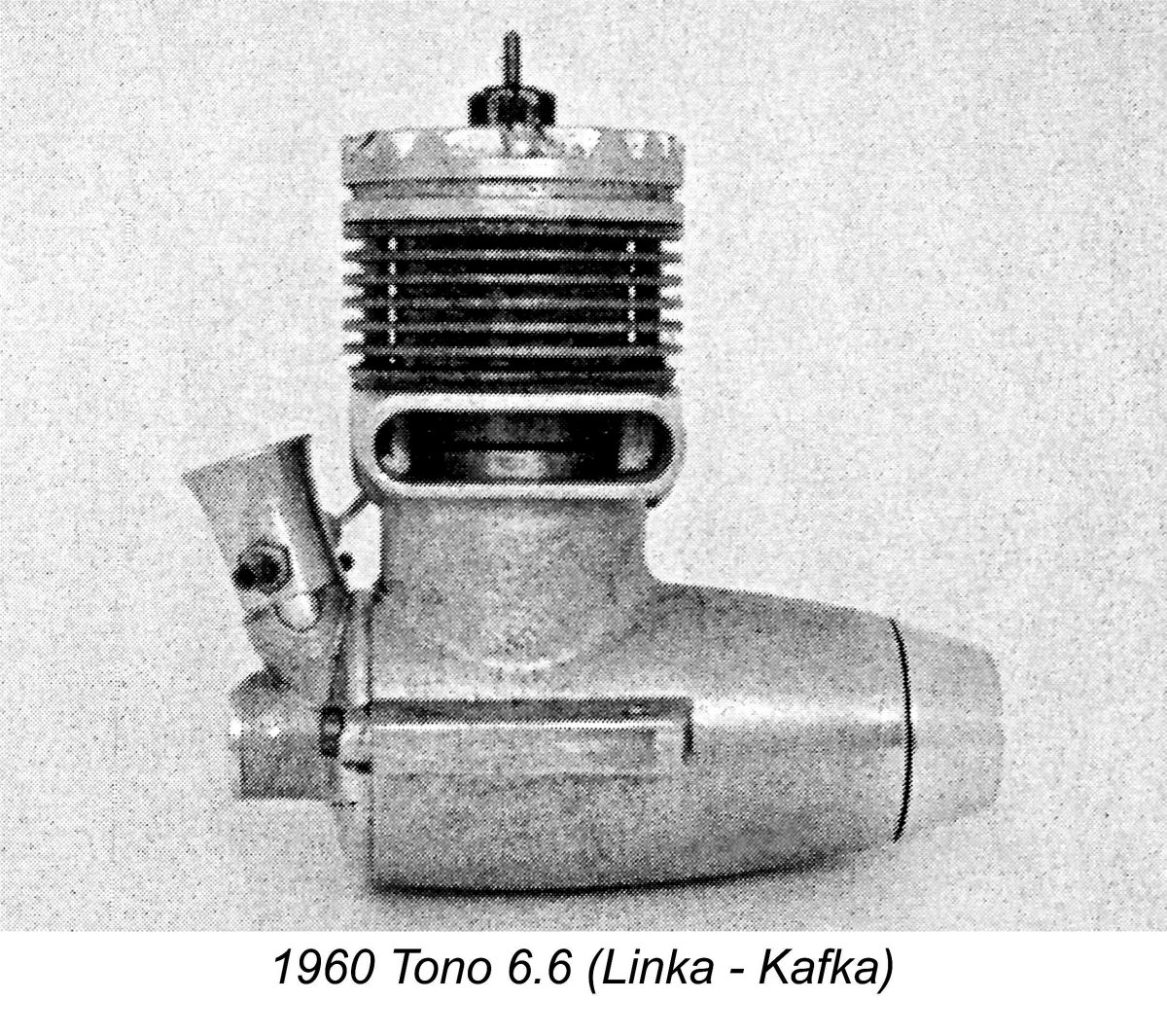 The 4.4 cc model featured bore and stroke dimensions of 19 mm x 16.3 mm and weighed 160 gm. Kalina reported that it was designed for operation in the 12,000 – 14,000 RPM range, but did not give any specific performance figures. The 5.6 cc and 6.6 cc models shared a common stroke of 17.3 mm but had bore dimensions of 20.3 mm and 22.0 mm respectively. They weighed 225 gm and 230 gm respectively.
The 4.4 cc model featured bore and stroke dimensions of 19 mm x 16.3 mm and weighed 160 gm. Kalina reported that it was designed for operation in the 12,000 – 14,000 RPM range, but did not give any specific performance figures. The 5.6 cc and 6.6 cc models shared a common stroke of 17.3 mm but had bore dimensions of 20.3 mm and 22.0 mm respectively. They weighed 225 gm and 230 gm respectively.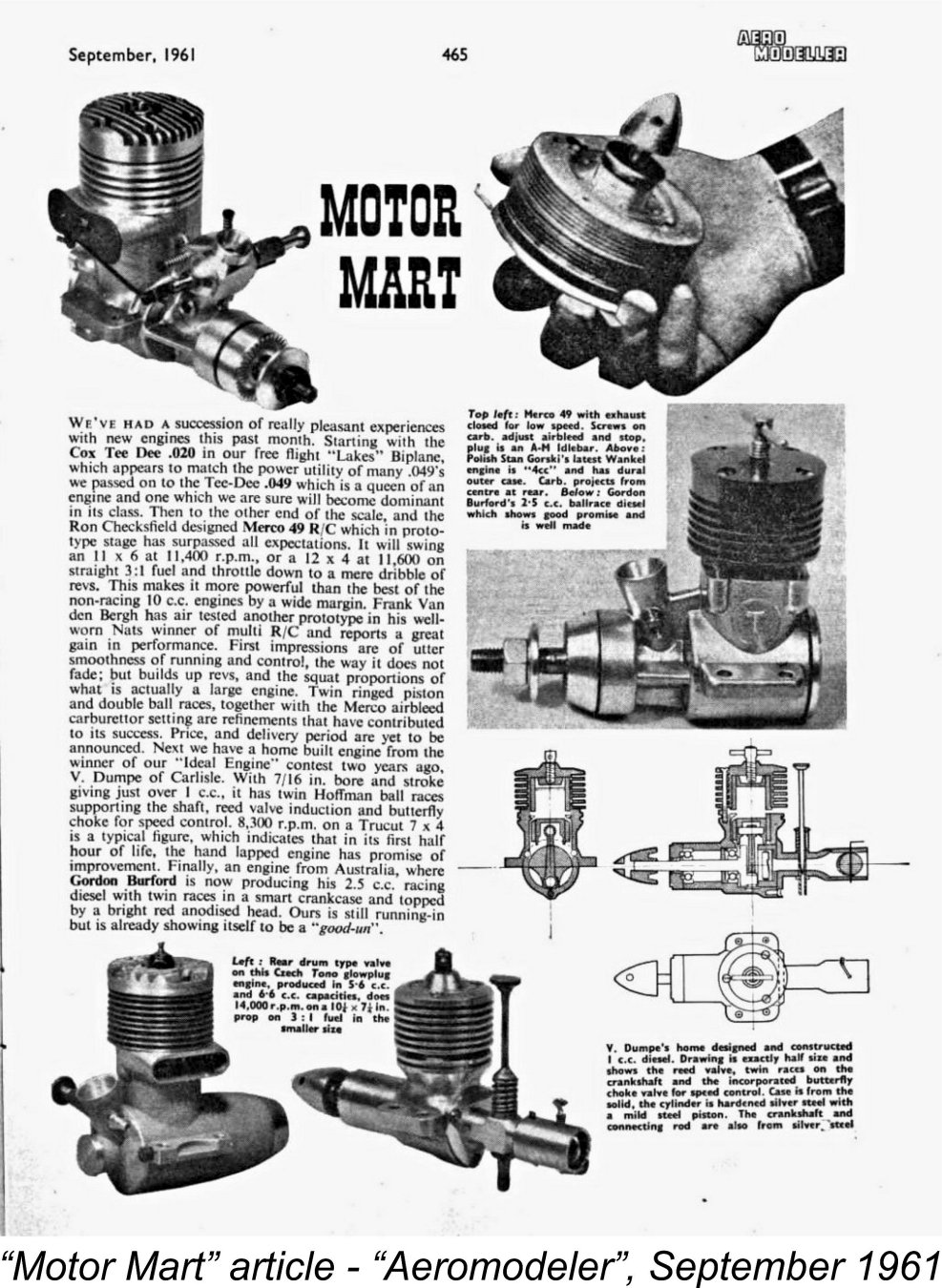 In view of the difficulty of obtaining supplies of nitro-methane in Czechoslovakia and other Eastern Bloc countries, the Tono engines were designed to run on a straight fuel mixture of 75% methanol and 25% castor oil. In keeping with this design criterion, they had relatively high compression ratios ranging from 8.5:1 up to as much as 12:1.
In view of the difficulty of obtaining supplies of nitro-methane in Czechoslovakia and other Eastern Bloc countries, the Tono engines were designed to run on a straight fuel mixture of 75% methanol and 25% castor oil. In keeping with this design criterion, they had relatively high compression ratios ranging from 8.5:1 up to as much as 12:1. 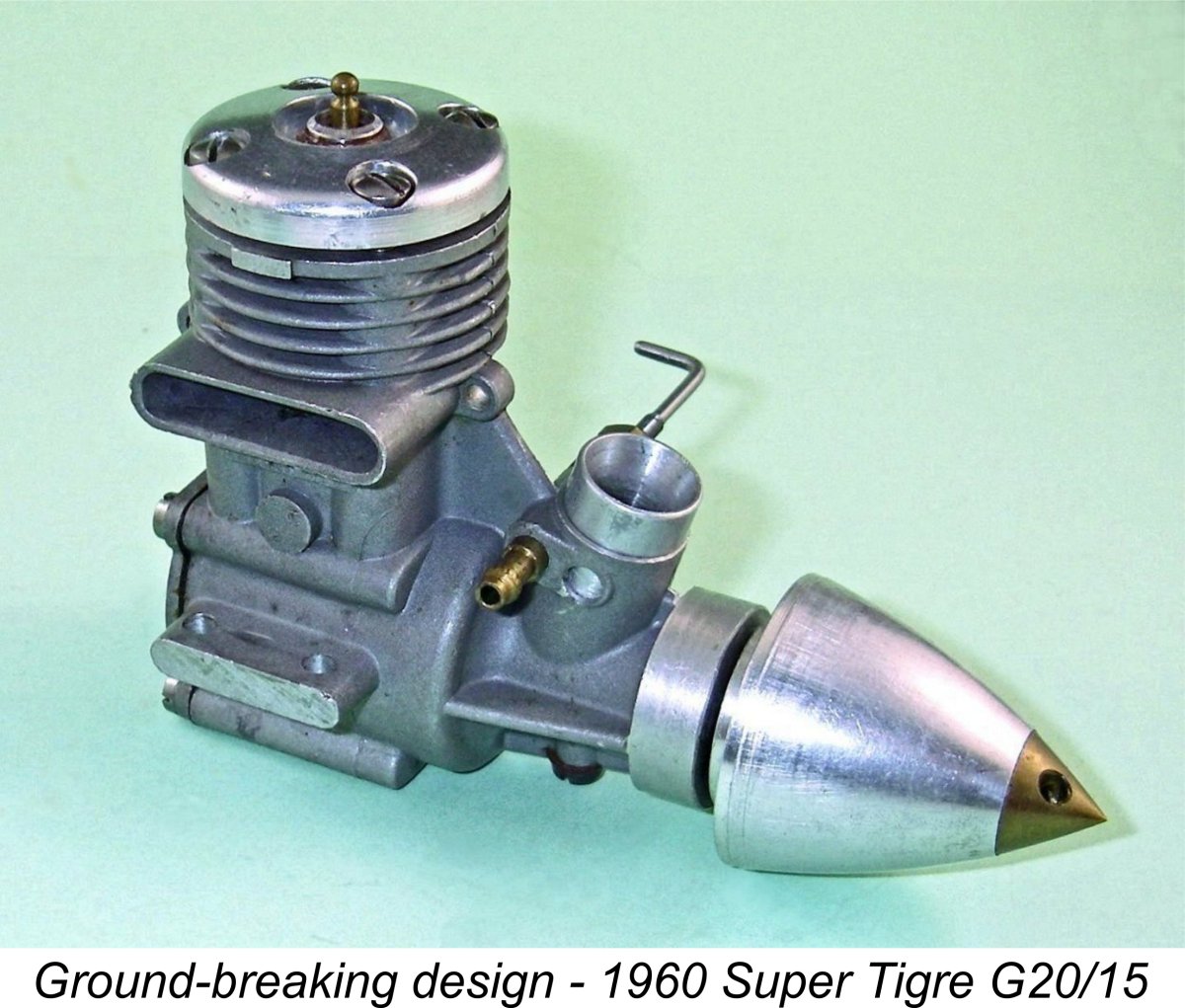 In fact, the cylinder porting now bore more than a passing resemblance to that which had been used very successfully since 1960 by Super Tigre beginning with their ground-breaking G20/15V "Jubilee" model. During the following years, Super Tigre had convincingly demonstrated the practicality of discarding the baffle which had long been a feature of cross-flow loop-scavenged engines. The greatest advantage of eliminating the baffle was the freedom which it gave the designer to create a more efficient combustion chamber configuration.
In fact, the cylinder porting now bore more than a passing resemblance to that which had been used very successfully since 1960 by Super Tigre beginning with their ground-breaking G20/15V "Jubilee" model. During the following years, Super Tigre had convincingly demonstrated the practicality of discarding the baffle which had long been a feature of cross-flow loop-scavenged engines. The greatest advantage of eliminating the baffle was the freedom which it gave the designer to create a more efficient combustion chamber configuration. 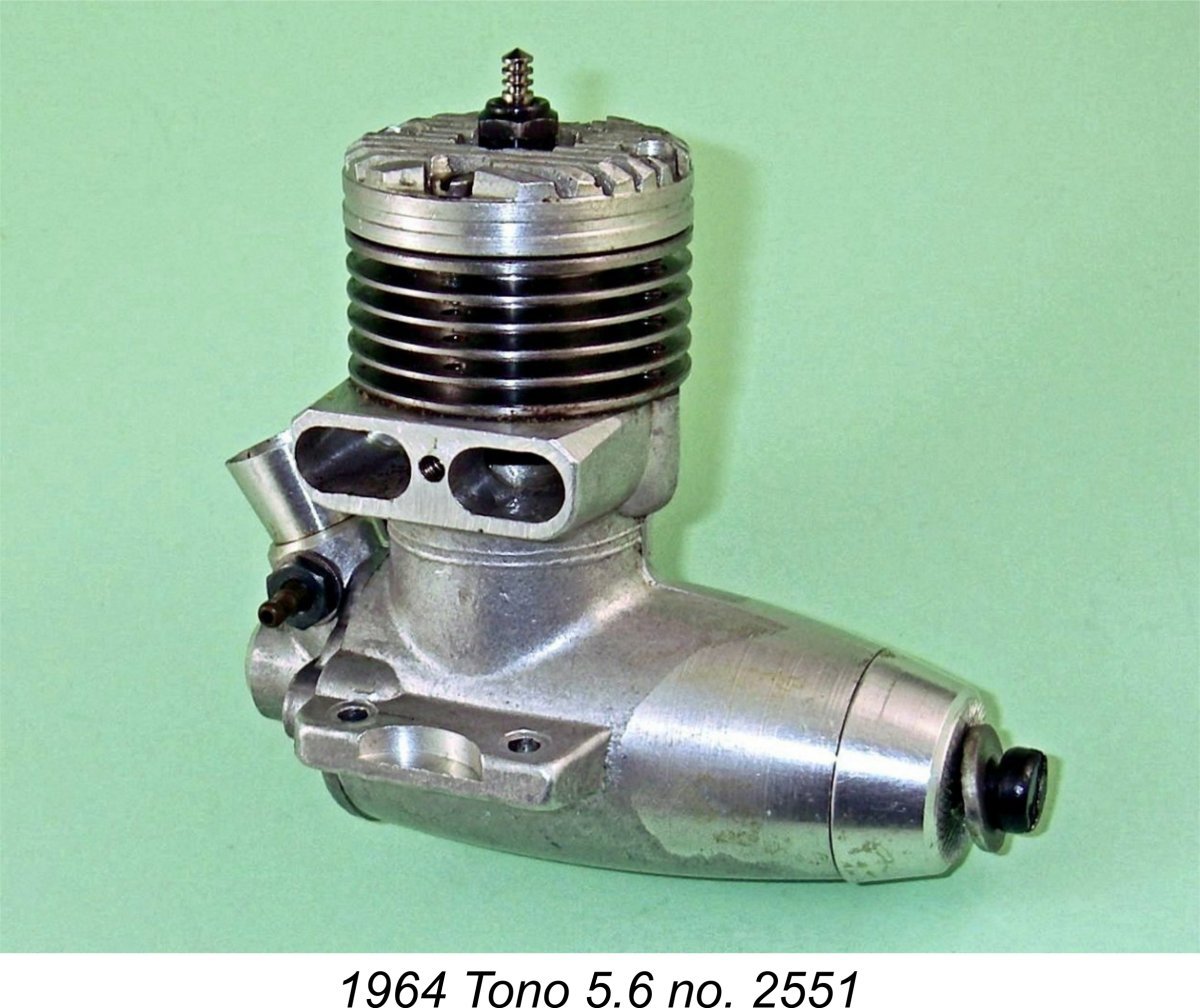 Kalina notes that by this time the makers were recommending a straight methanol/castor fuel with a small proportion of added benzene. Presumably that material was more accessible in Czechoslovakia at the time than nitro-methane. Definitely not a recommended fuel ingredient today – benzene is a powerful carcinogen having a whole range of other health effects in addition. Steer well clear ......
Kalina notes that by this time the makers were recommending a straight methanol/castor fuel with a small proportion of added benzene. Presumably that material was more accessible in Czechoslovakia at the time than nitro-methane. Definitely not a recommended fuel ingredient today – benzene is a powerful carcinogen having a whole range of other health effects in addition. Steer well clear ......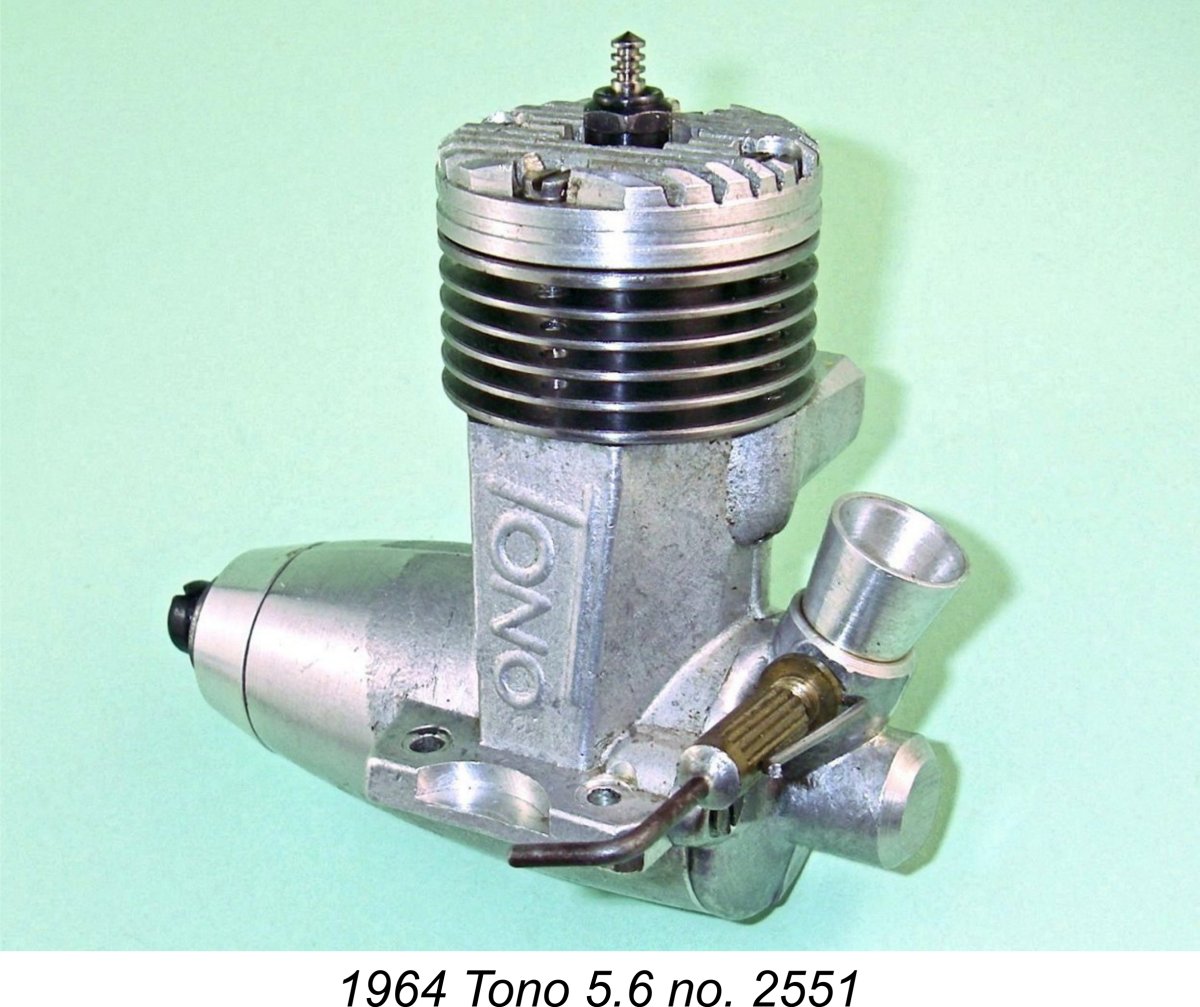 Claimed output for this engine was a sturdy 0.778 BHP at 16,000 RPM, a figure which is actually more believable than that given for the earlier 5.5 cc model, mainly because of the significantly higher rpm figure. In fact, it makes it even more difficult to believe that the 12,000 RPM peak speed given for the 5.5 is accurate – after all, the two engines were of similar design and very similar displacements ……….. However, an increase in BHP from 0.720 BHP to 0.778 BHP from the 5.43 cc to the 5.56 cc version seems quite believable.
Claimed output for this engine was a sturdy 0.778 BHP at 16,000 RPM, a figure which is actually more believable than that given for the earlier 5.5 cc model, mainly because of the significantly higher rpm figure. In fact, it makes it even more difficult to believe that the 12,000 RPM peak speed given for the 5.5 is accurate – after all, the two engines were of similar design and very similar displacements ……….. However, an increase in BHP from 0.720 BHP to 0.778 BHP from the 5.43 cc to the 5.56 cc version seems quite believable. 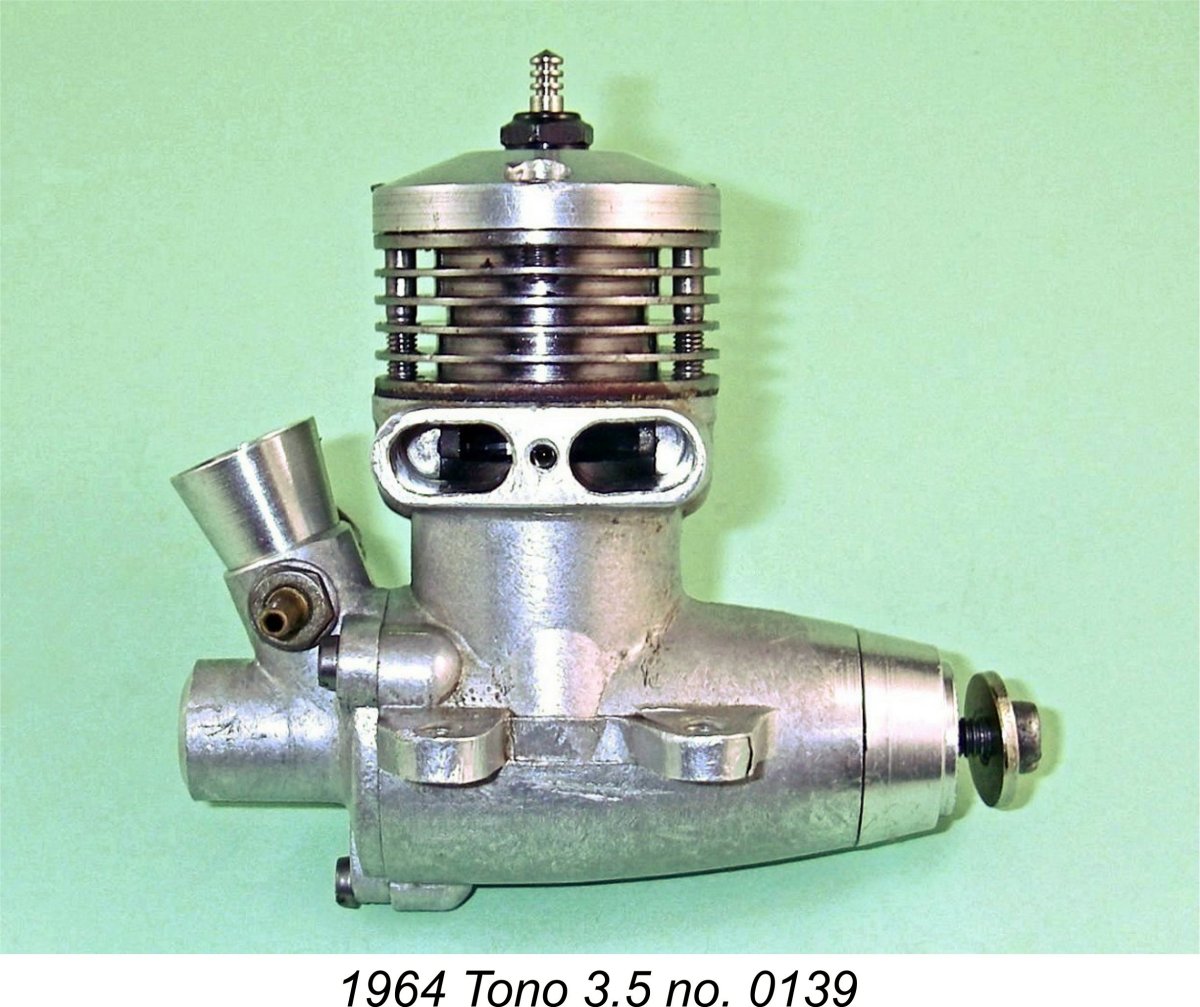 Another 1964 offering from the Tono factory was the so-called Tono 3.5. This engine used the same deflectorless piston technology as its larger relatives. But here the factory reverted to the style established with their very first model, the Tono 1 – they designated the engine with a number that was in fact some way short of its actual displacement! The Tono 3.5, my example of which is illustrated in the attached photographs, had bore and stroke measurements of 17.5 mm x 16.0 mm for an actual displacement of 3.85 cc (0.235 cuin.). The illustrated un-throttled engine weighs a checked 180 gm (6.35 ounces), which interestingly enough is slightly heavier than the reported weight of 160 gm (5.64 ounces) for the larger-displacement 4.4 cc model mentioned earlier!
Another 1964 offering from the Tono factory was the so-called Tono 3.5. This engine used the same deflectorless piston technology as its larger relatives. But here the factory reverted to the style established with their very first model, the Tono 1 – they designated the engine with a number that was in fact some way short of its actual displacement! The Tono 3.5, my example of which is illustrated in the attached photographs, had bore and stroke measurements of 17.5 mm x 16.0 mm for an actual displacement of 3.85 cc (0.235 cuin.). The illustrated un-throttled engine weighs a checked 180 gm (6.35 ounces), which interestingly enough is slightly heavier than the reported weight of 160 gm (5.64 ounces) for the larger-displacement 4.4 cc model mentioned earlier! 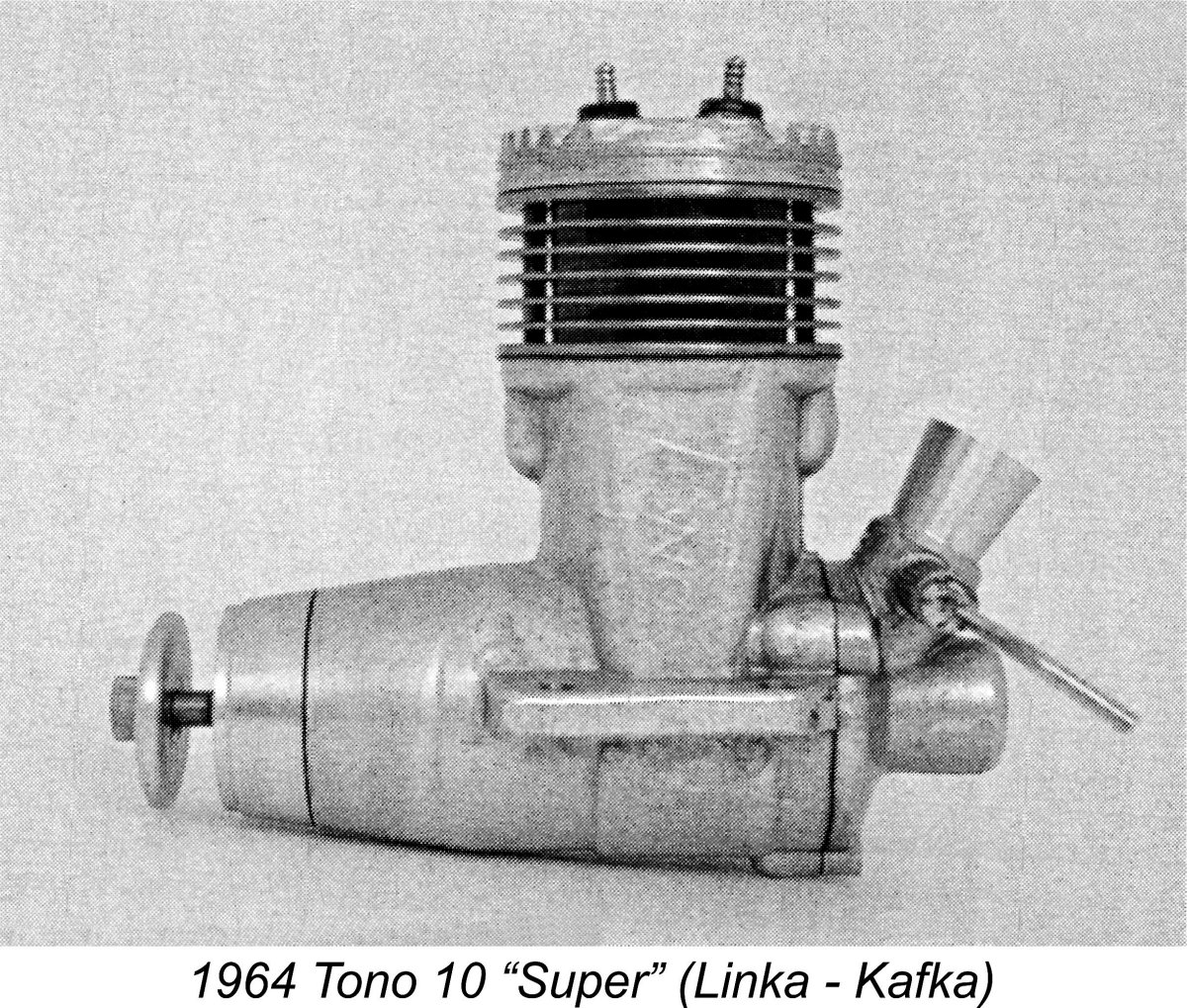 largest engine ever made by the factory, were 25 mm and 20.0 mm respectively for an actual displacement of 9.84 cc (0.600 cuin.). Claimed output of this model was 1.06 BHP at unspecified rpm. Again, this appears to be a quite believable figure based on the engine’s specification and quality of construction.
largest engine ever made by the factory, were 25 mm and 20.0 mm respectively for an actual displacement of 9.84 cc (0.600 cuin.). Claimed output of this model was 1.06 BHP at unspecified rpm. Again, this appears to be a quite believable figure based on the engine’s specification and quality of construction. 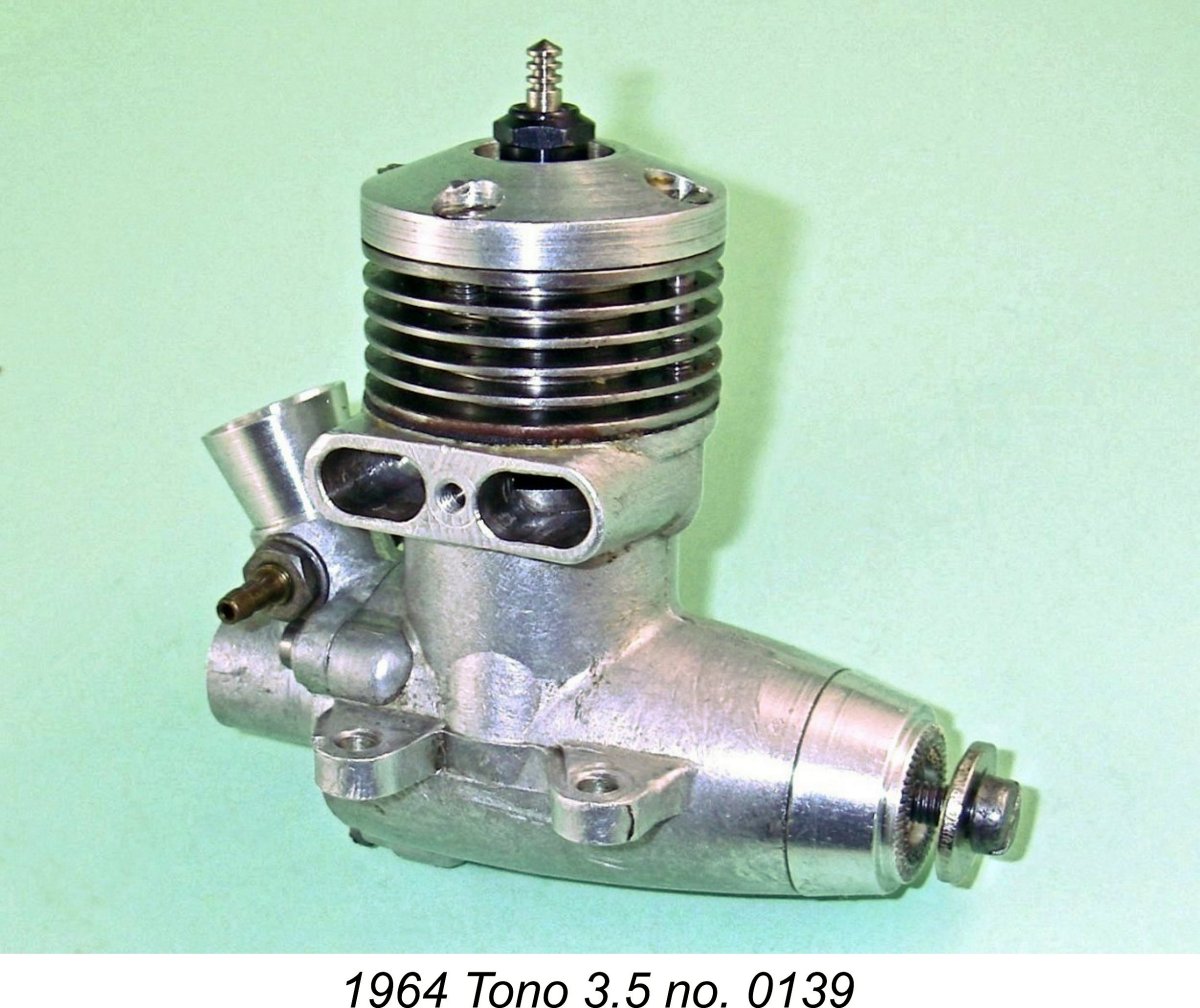 Overall, I would rate these engines as above-average performers by the standards of their day. They were also very well made indeed in addition to being cleverly and attractively designed, hence doubtless being well able to give long and highly satisfactory service. The only criticisms which I can offer are the somewhat excessive weight for their size and the rather shallow knurling on the prop drivers, coupled with totally inadequate slot-head prop mounting screws. The engines have relatively high compression in order to be able to run on low nitro fuels, and they do have a tendency to kick back on starting, often loosening the prop. The use of more effective knurling and rather more substantial prop fastening screws would have done much to counter this tendency.
Overall, I would rate these engines as above-average performers by the standards of their day. They were also very well made indeed in addition to being cleverly and attractively designed, hence doubtless being well able to give long and highly satisfactory service. The only criticisms which I can offer are the somewhat excessive weight for their size and the rather shallow knurling on the prop drivers, coupled with totally inadequate slot-head prop mounting screws. The engines have relatively high compression in order to be able to run on low nitro fuels, and they do have a tendency to kick back on starting, often loosening the prop. The use of more effective knurling and rather more substantial prop fastening screws would have done much to counter this tendency. 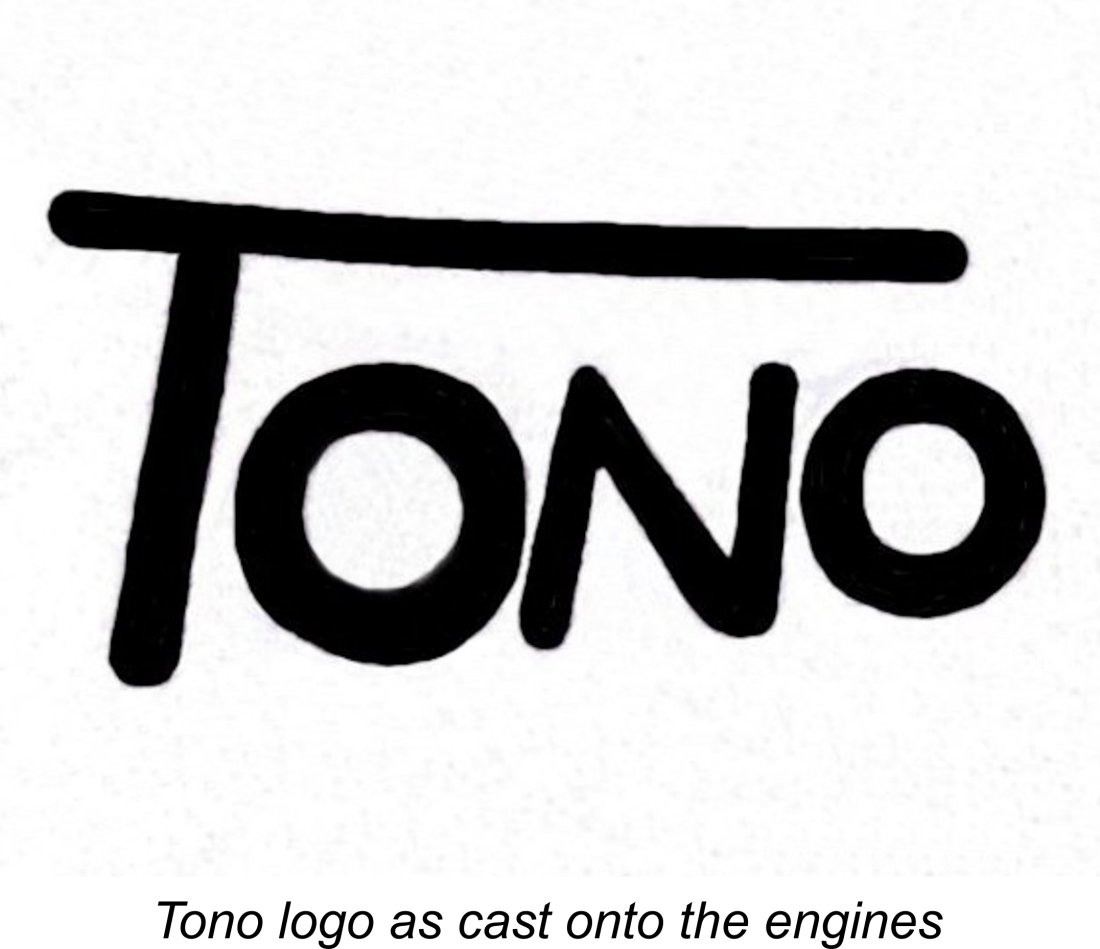 The Tono engines were all provided with serial numbers. Reader Bill Wells reported owning 1964 5.6 cc model no. 217, while my own illustrated example of that model bears the serial number 2551. My illustrated 3.5 cc (more properly 3.8 cc!) model of the same year bears serial number 0139. The 3.5 cc example formerly owned by the late Ron Draper reportedly bore the number 828.
The Tono engines were all provided with serial numbers. Reader Bill Wells reported owning 1964 5.6 cc model no. 217, while my own illustrated example of that model bears the serial number 2551. My illustrated 3.5 cc (more properly 3.8 cc!) model of the same year bears serial number 0139. The 3.5 cc example formerly owned by the late Ron Draper reportedly bore the number 828.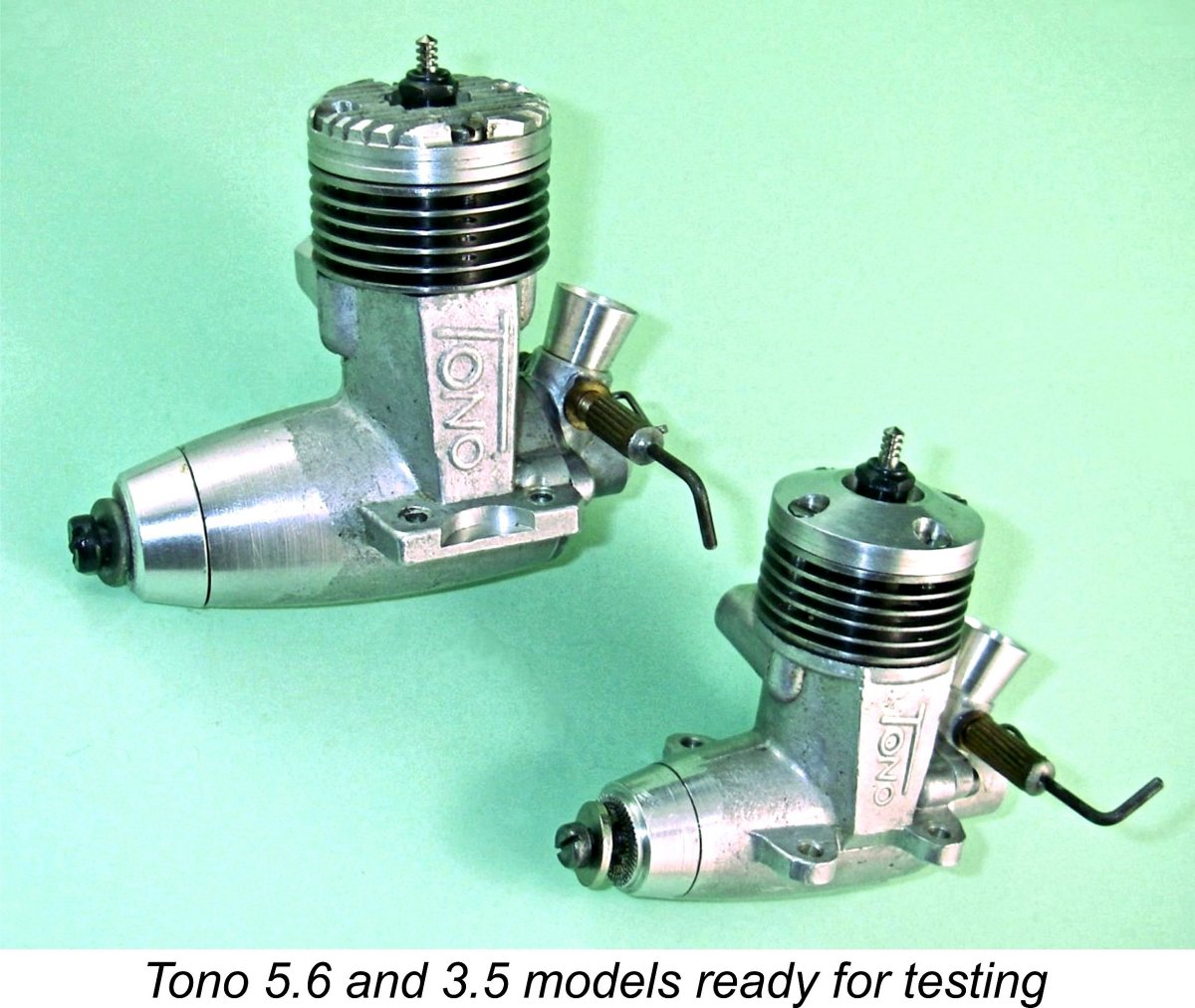 To assist in the development of some kind of performance assessment for the Tono engines, I was fortunate enough to have available nice examples of both the 5.6 cc and 3.8 cc (nominally 3.5 cc) variants of the basic deflectorless Tono design from 1964. I’ve had these engines for many years now – I no longer even recall exactly when and where I acquired them! However, apart from a few preliminary trial runs way back when, I had no previous operational experience with either of them.
To assist in the development of some kind of performance assessment for the Tono engines, I was fortunate enough to have available nice examples of both the 5.6 cc and 3.8 cc (nominally 3.5 cc) variants of the basic deflectorless Tono design from 1964. I’ve had these engines for many years now – I no longer even recall exactly when and where I acquired them! However, apart from a few preliminary trial runs way back when, I had no previous operational experience with either of them.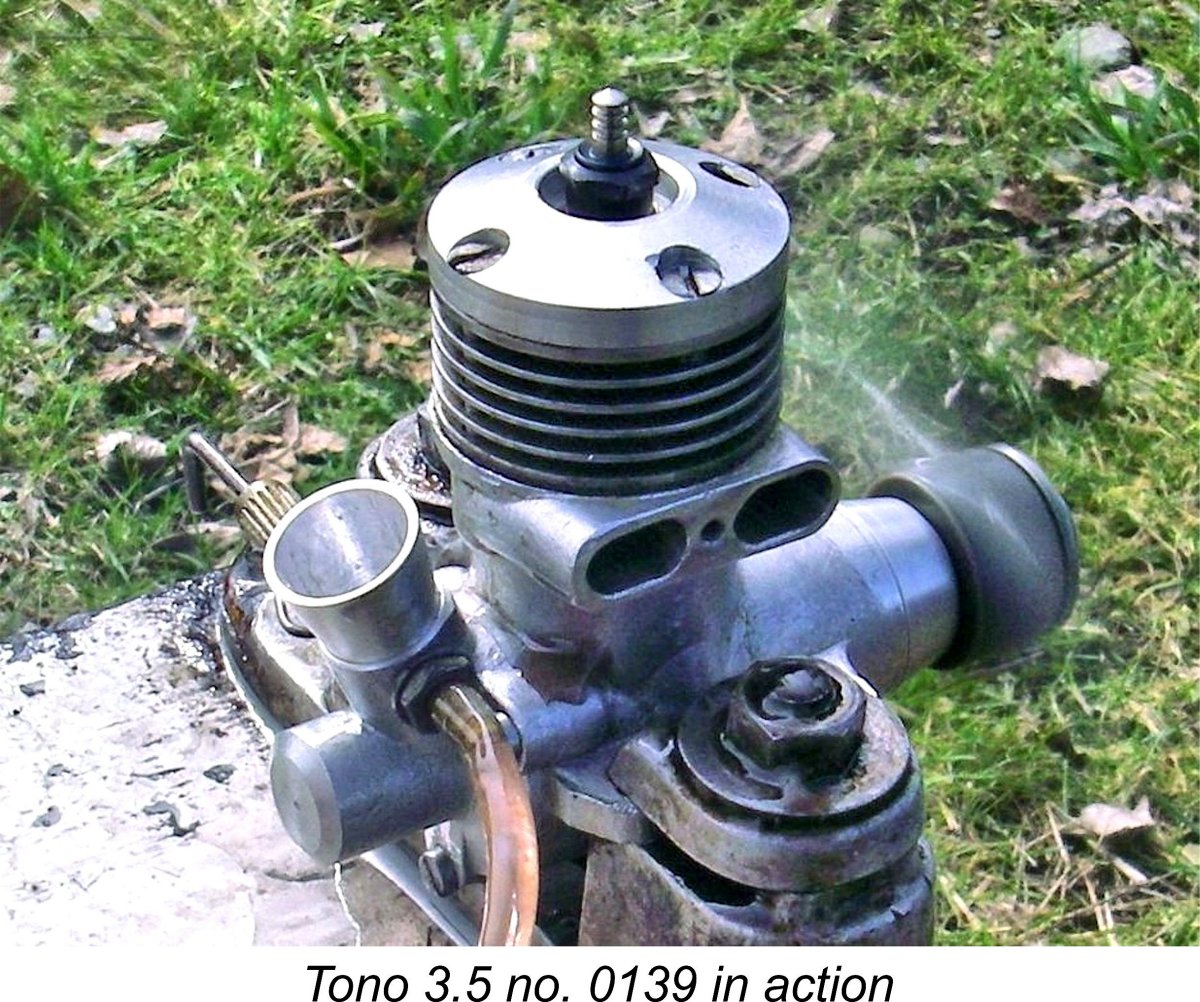 The engine proved to be a very quick starter once the appropriate technique was established. To begin with, it needed a prime for starting. However, I found that when wet after a prime the engine had a bit of a tendency to start backwards. Oddly enough, it would keep running in that direction, although not with any power or authority. I found that the old "reverse bounce" racing engine technique worked very well in this condition - prime, light the plug, set the prop at bottom dead centre and then hit the prop backwards against compression. The engine almost invariably backfired and started immediately in the correct direction using this method.
The engine proved to be a very quick starter once the appropriate technique was established. To begin with, it needed a prime for starting. However, I found that when wet after a prime the engine had a bit of a tendency to start backwards. Oddly enough, it would keep running in that direction, although not with any power or authority. I found that the old "reverse bounce" racing engine technique worked very well in this condition - prime, light the plug, set the prop at bottom dead centre and then hit the prop backwards against compression. The engine almost invariably backfired and started immediately in the correct direction using this method. 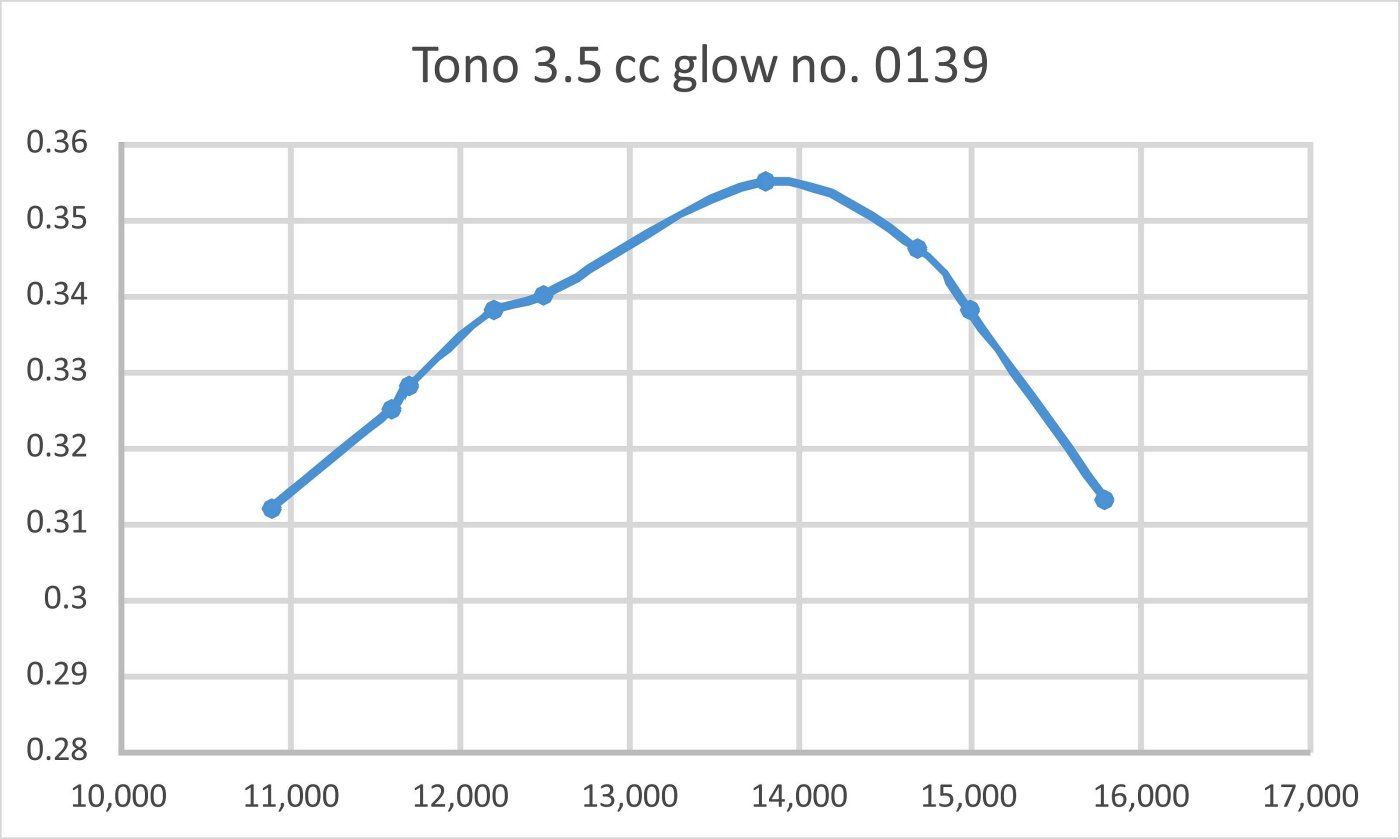
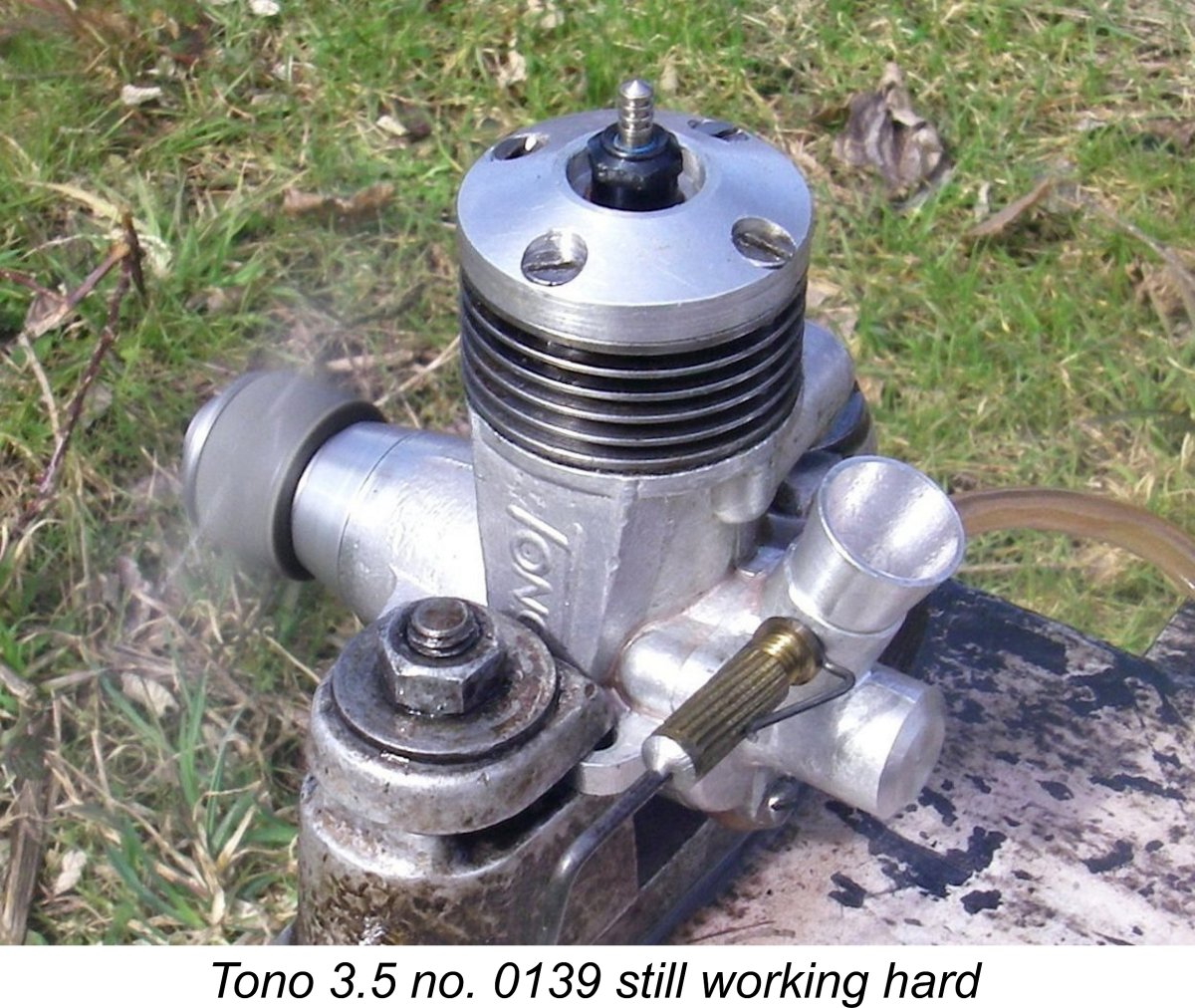 The APC 8x4 WB is a cut-down APC 9x4 intended to fill an otherwise glaring gap in the range of power absorption coefficients for my test set of props. As can be seen from the above data, its inclusion was very necessary in this case!
The APC 8x4 WB is a cut-down APC 9x4 intended to fill an otherwise glaring gap in the range of power absorption coefficients for my test set of props. As can be seen from the above data, its inclusion was very necessary in this case! 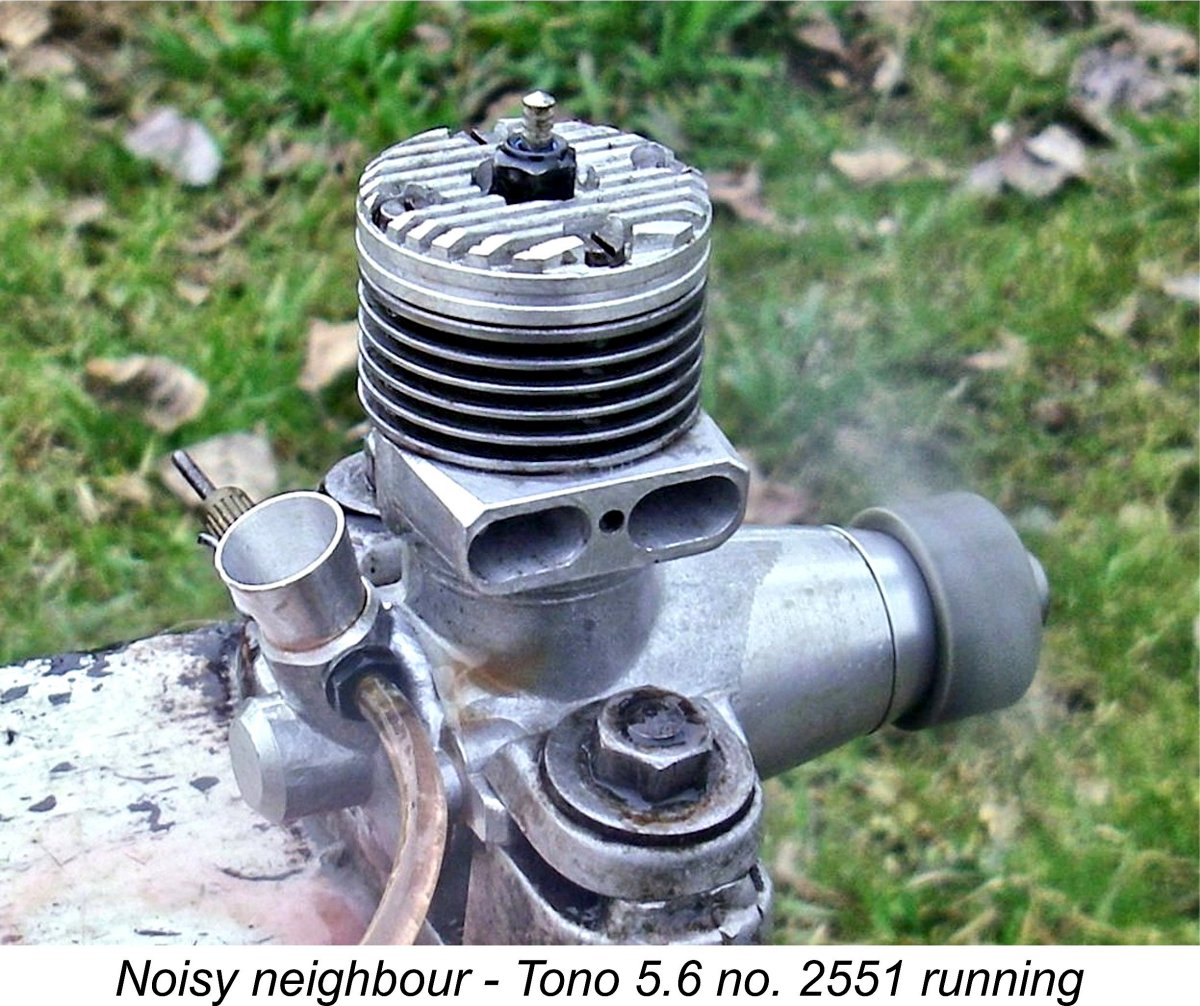 After the tests on the 3.5 were completed, it was the turn of the 5.6 cc model no. 2551. The handling characteristics of this example were very similar to those of the smaller model. The same tendency to start backwards was encountered, with the same "reverse bounce" remedy proving to be most effective. Running qualities were once again beyond reproach. The most noticeable difference was that the larger engine proved to be even more effective at turning money into noise than its smaller sibling - I was very glad of my industrial-grade ear-muffs!
After the tests on the 3.5 were completed, it was the turn of the 5.6 cc model no. 2551. The handling characteristics of this example were very similar to those of the smaller model. The same tendency to start backwards was encountered, with the same "reverse bounce" remedy proving to be most effective. Running qualities were once again beyond reproach. The most noticeable difference was that the larger engine proved to be even more effective at turning money into noise than its smaller sibling - I was very glad of my industrial-grade ear-muffs! 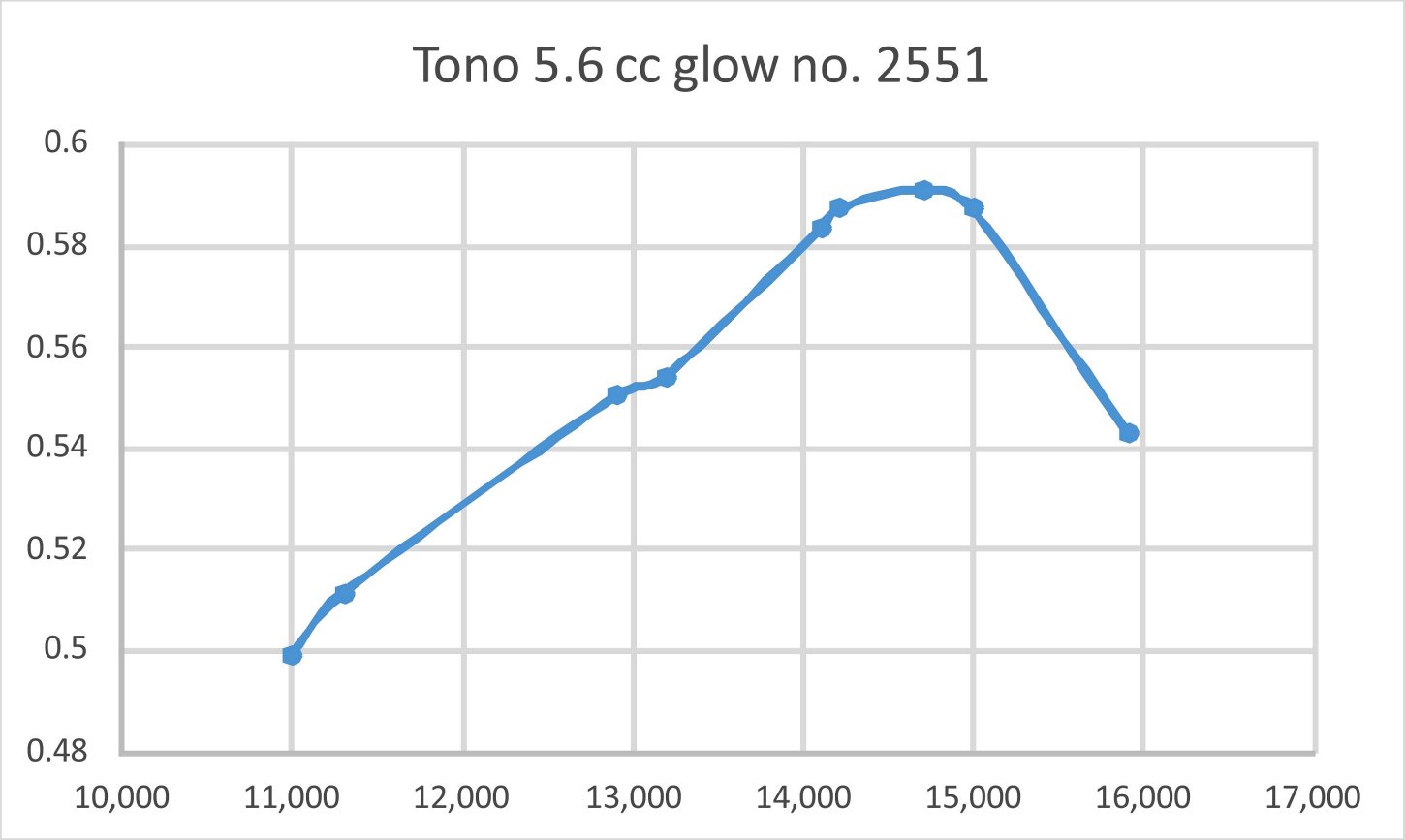
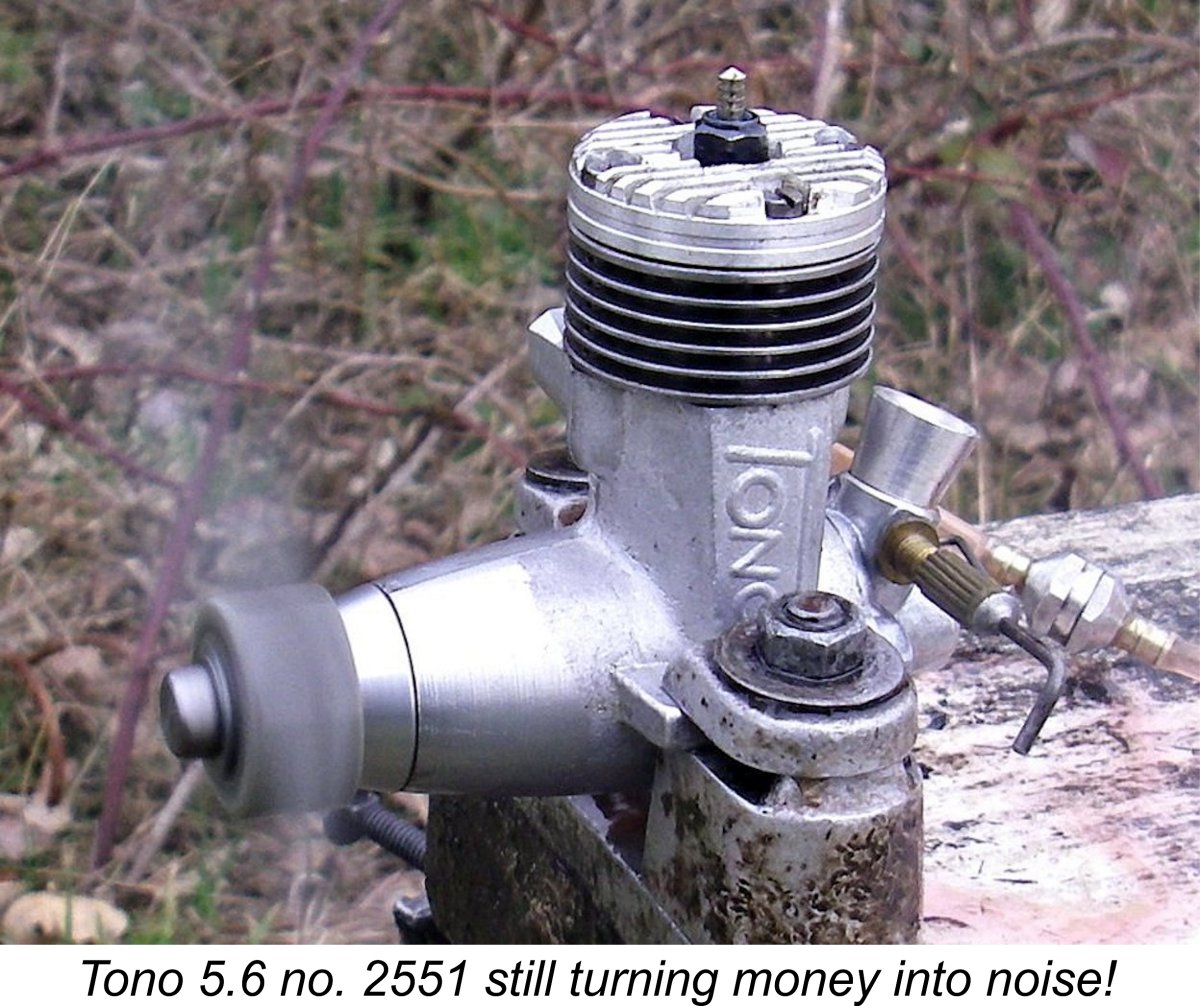 obtained on a higher-nitro fuel than the 5% brew that I used. I'm sure that both engines would perform at a measurably higher level on a 20% or more nitro brew. I can well believe that on such a fuel both engines might come pretty close to matching the manufacturer's claims.
obtained on a higher-nitro fuel than the 5% brew that I used. I'm sure that both engines would perform at a measurably higher level on a 20% or more nitro brew. I can well believe that on such a fuel both engines might come pretty close to matching the manufacturer's claims. 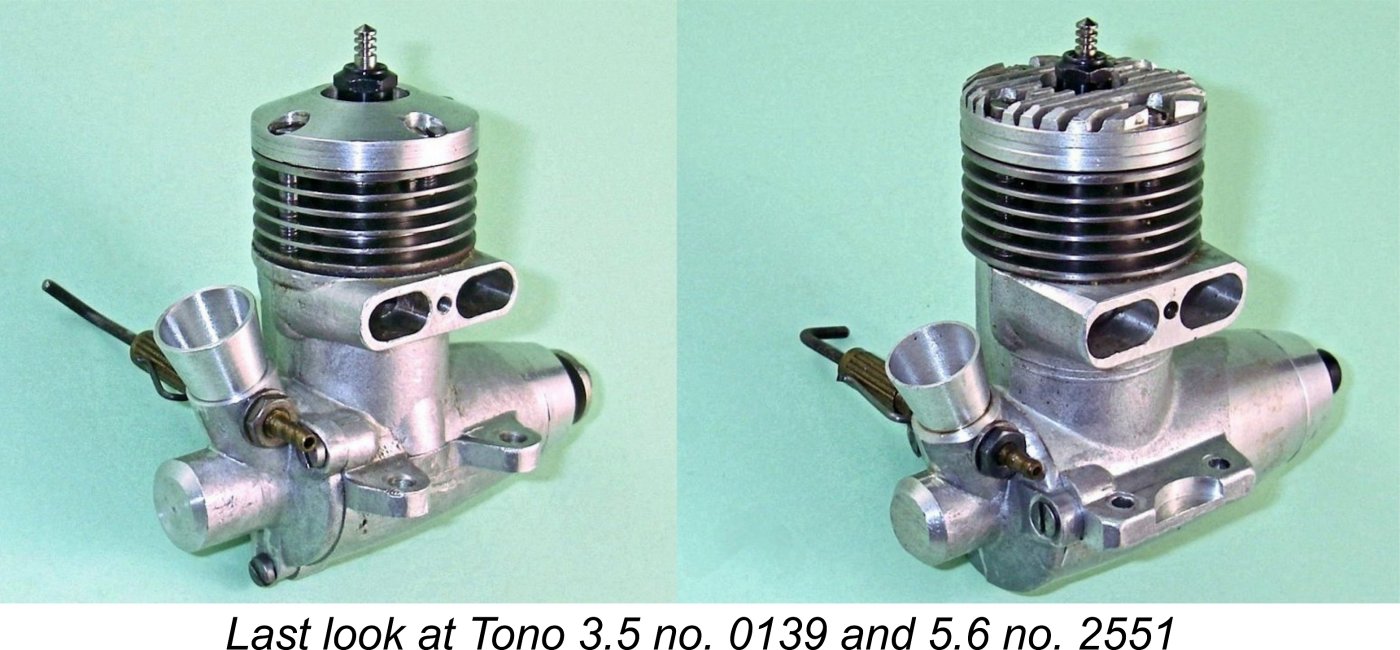 It's actually a little surprising that the Tono engines are not more widely appreciated outside of their zone of origin. Their qualities in terms of design, construction and performance undoutedly render them fully worthy of a great deal of respect. I suppose it's only the fact that they were never marketed with any fervour outside Czechoslovakia (as it was then) that kept them below the radars of most active modellers back in the day.
It's actually a little surprising that the Tono engines are not more widely appreciated outside of their zone of origin. Their qualities in terms of design, construction and performance undoutedly render them fully worthy of a great deal of respect. I suppose it's only the fact that they were never marketed with any fervour outside Czechoslovakia (as it was then) that kept them below the radars of most active modellers back in the day.